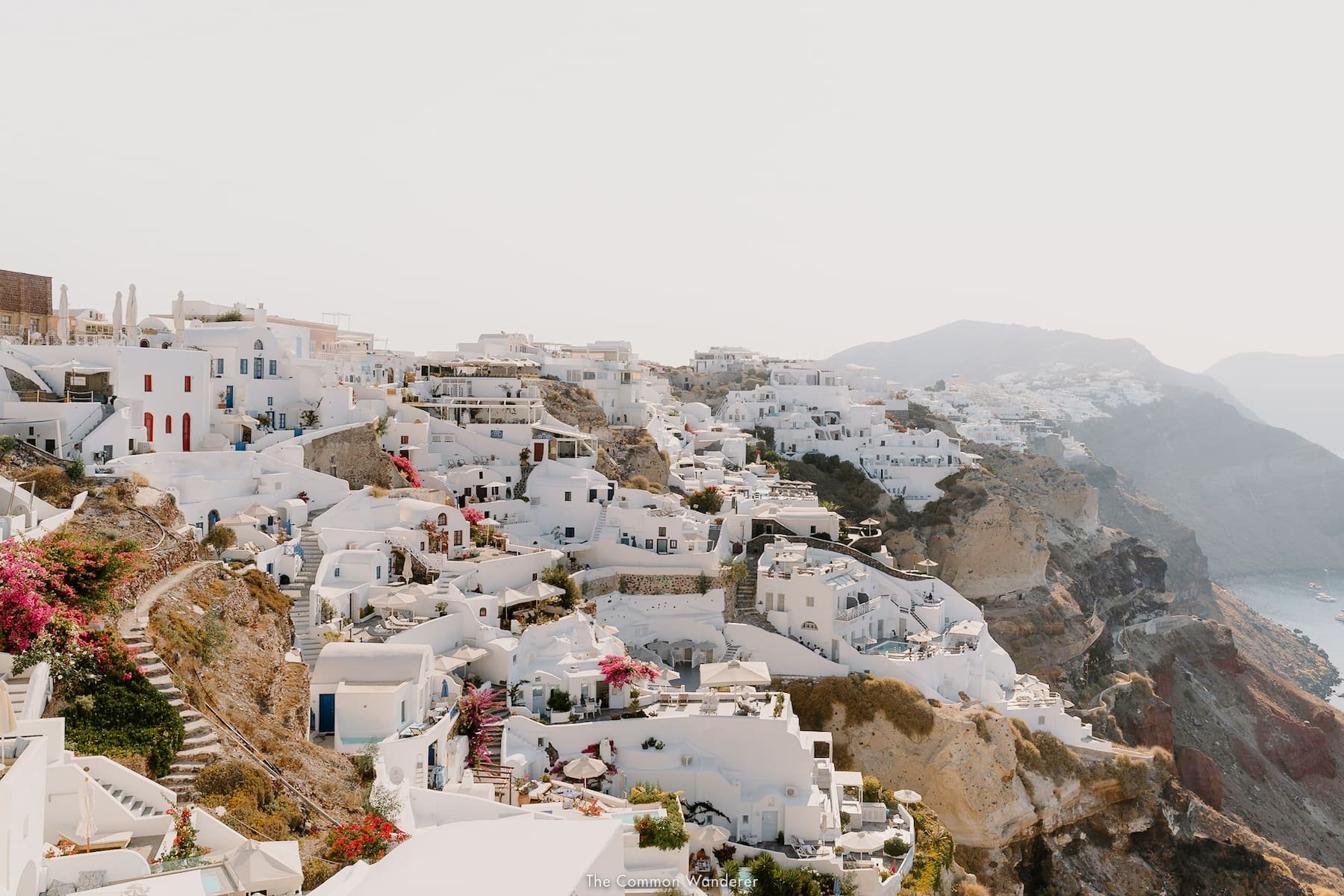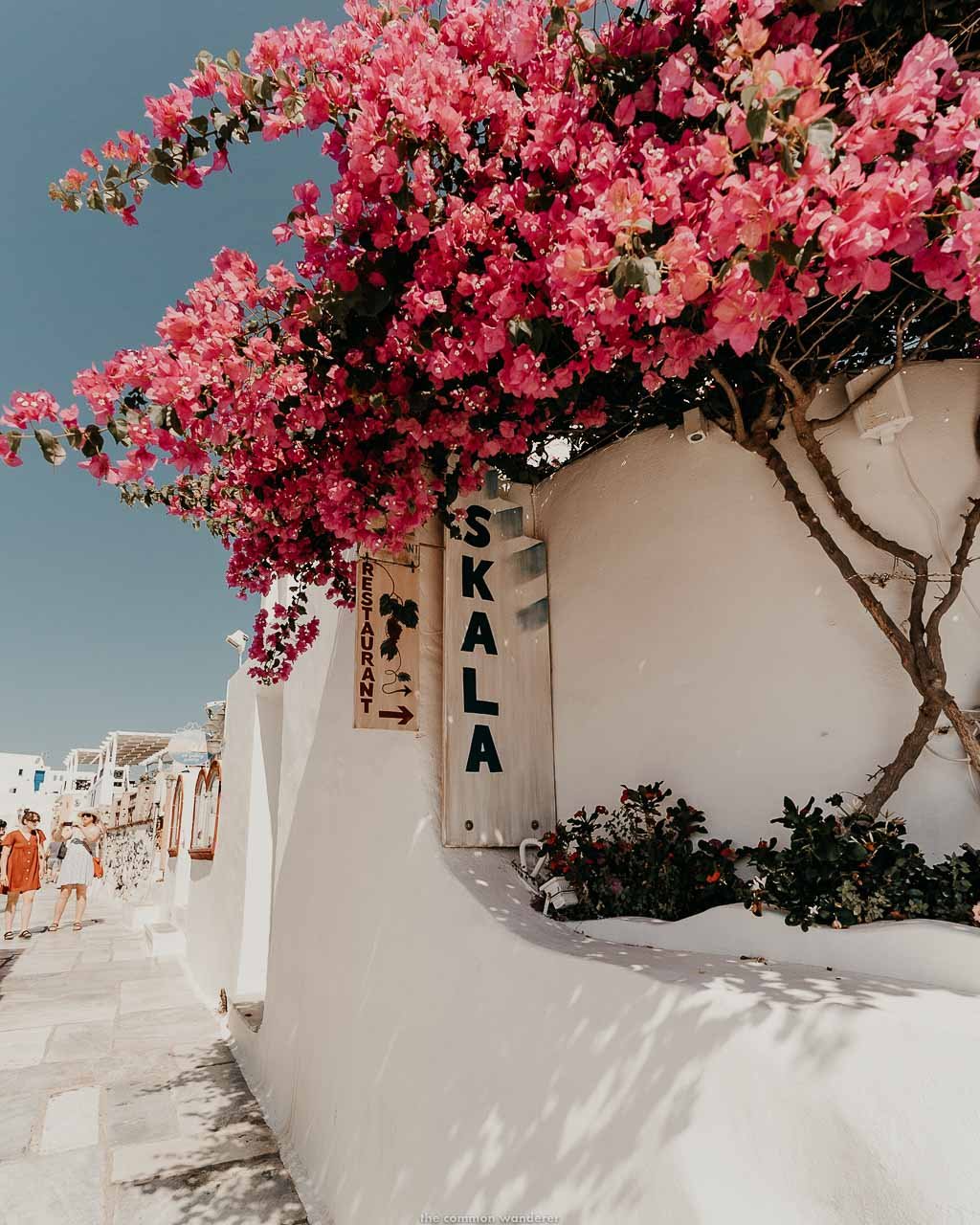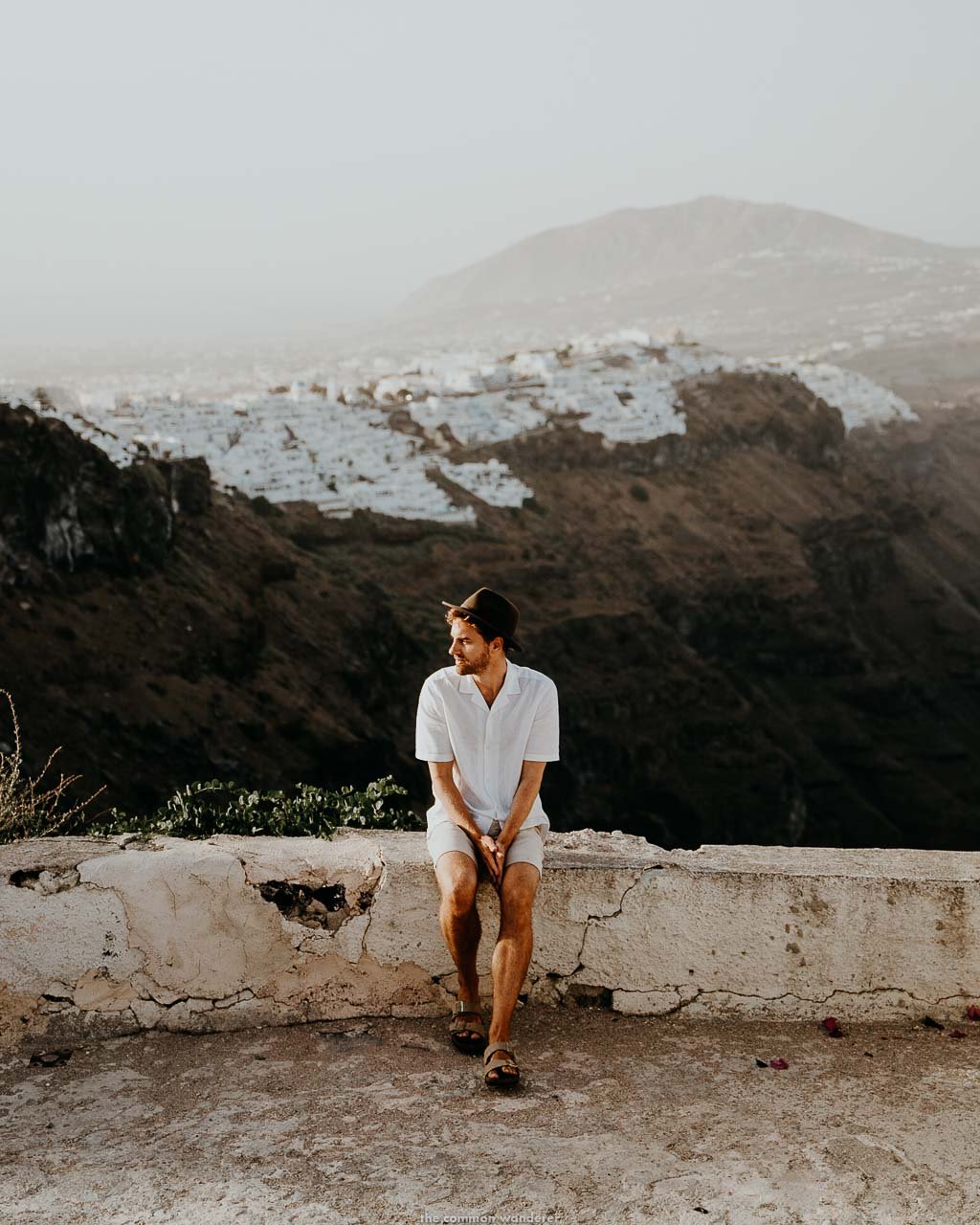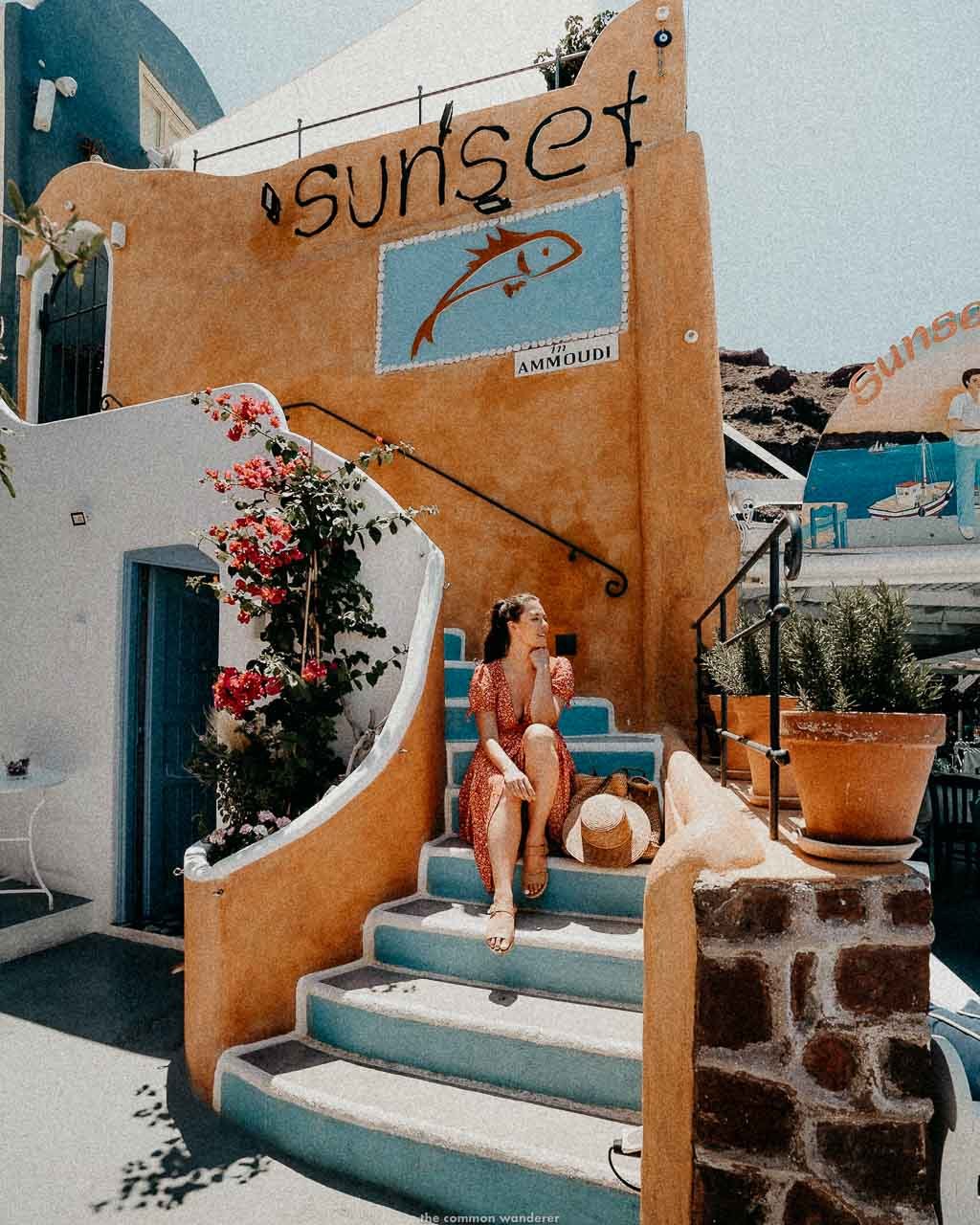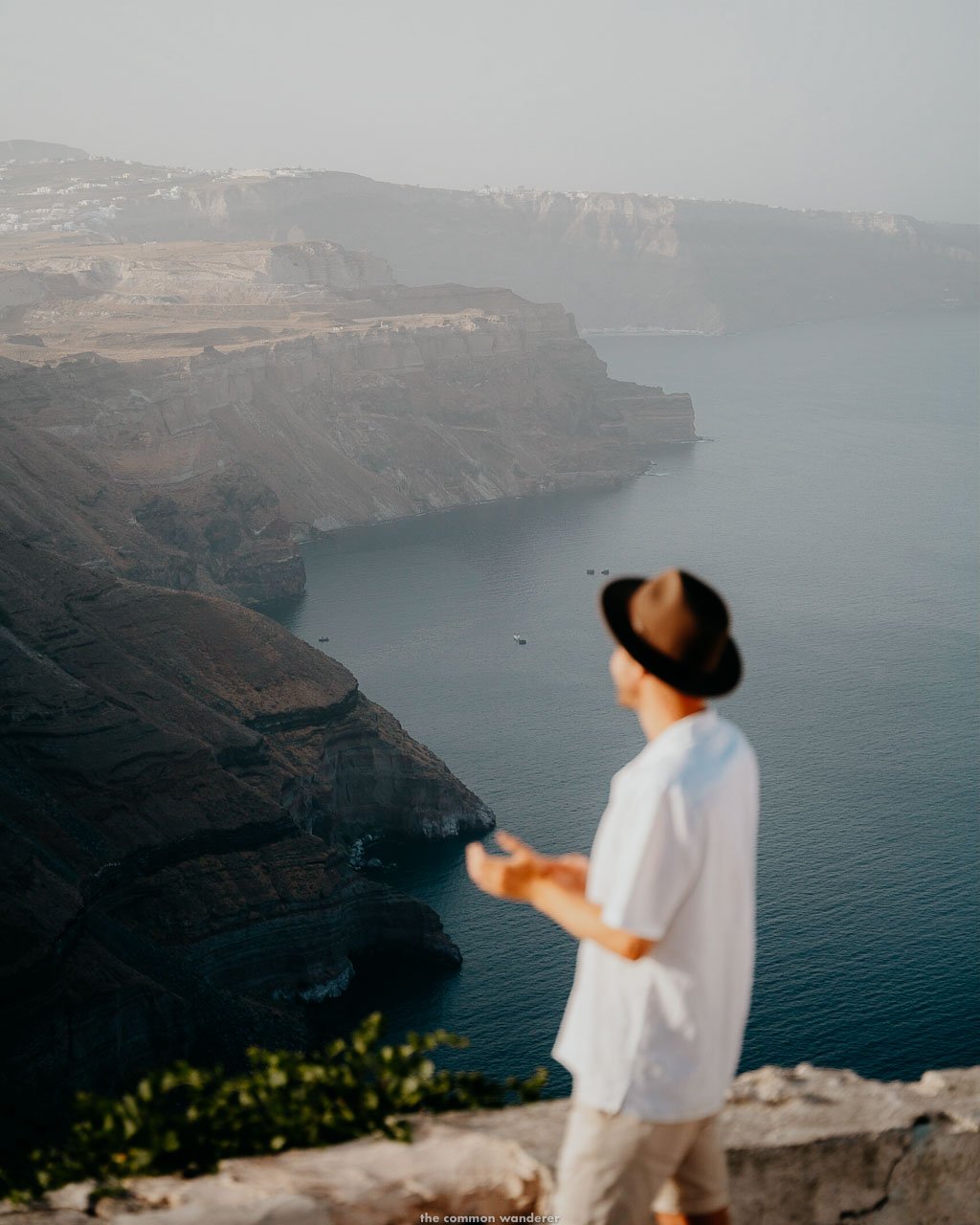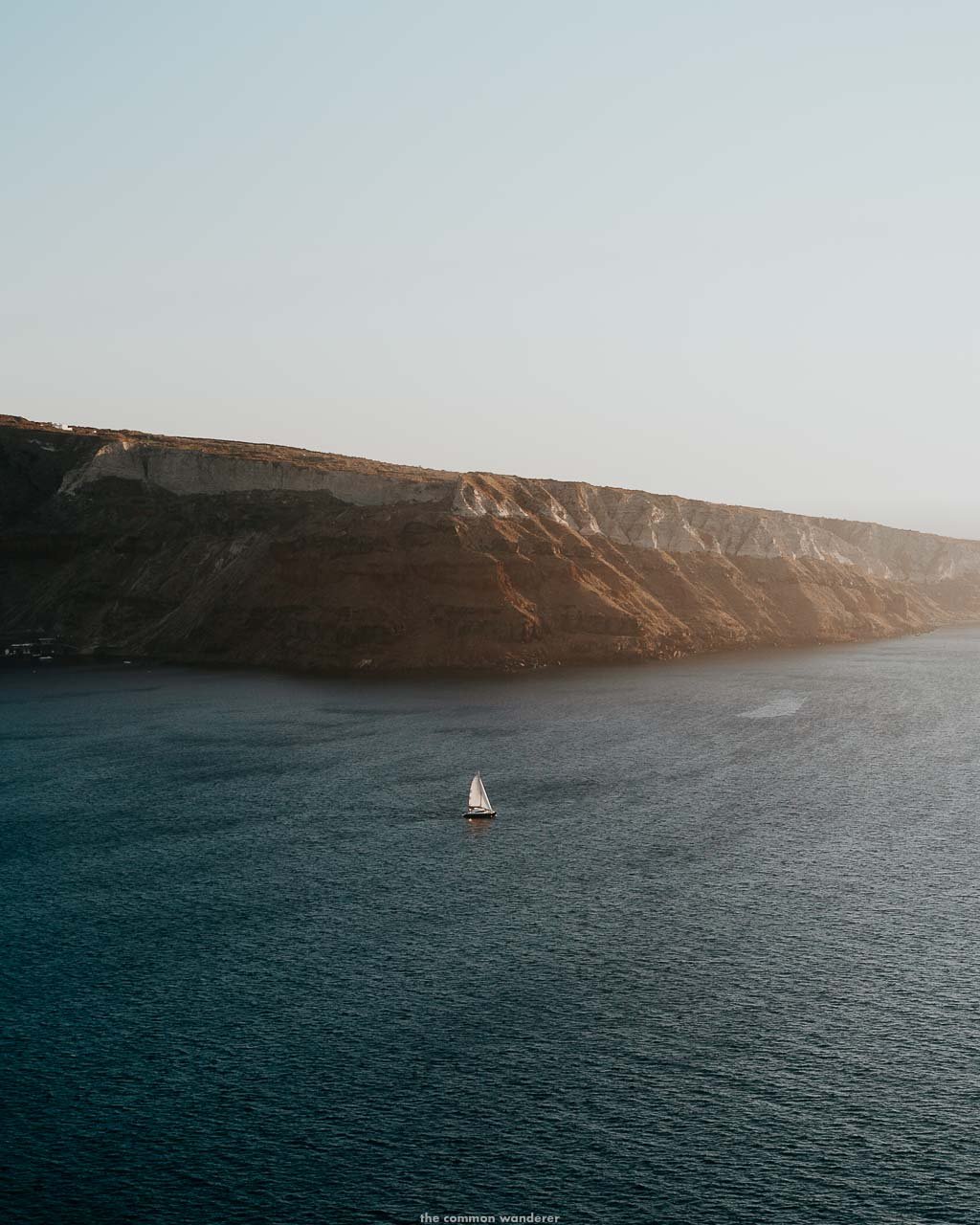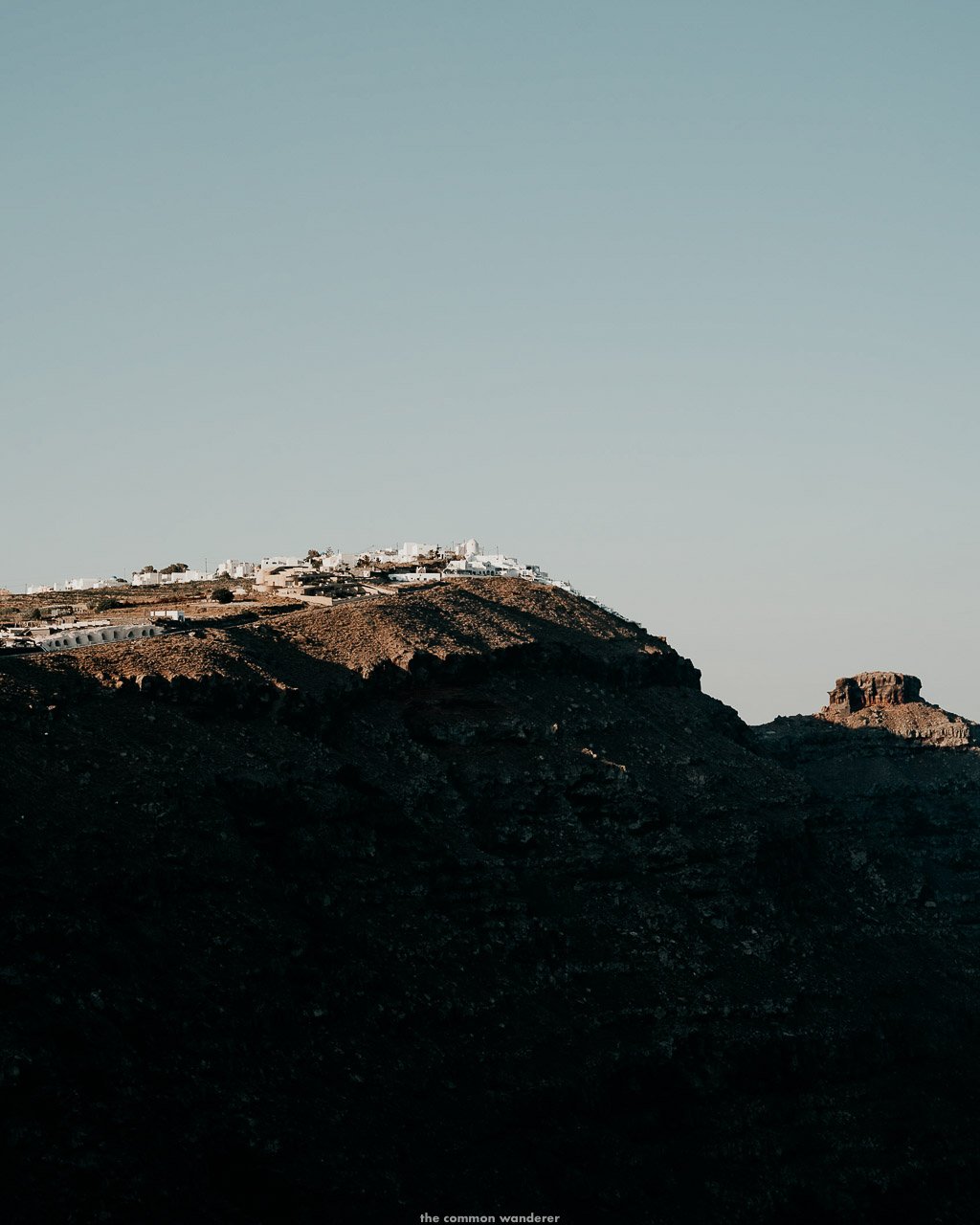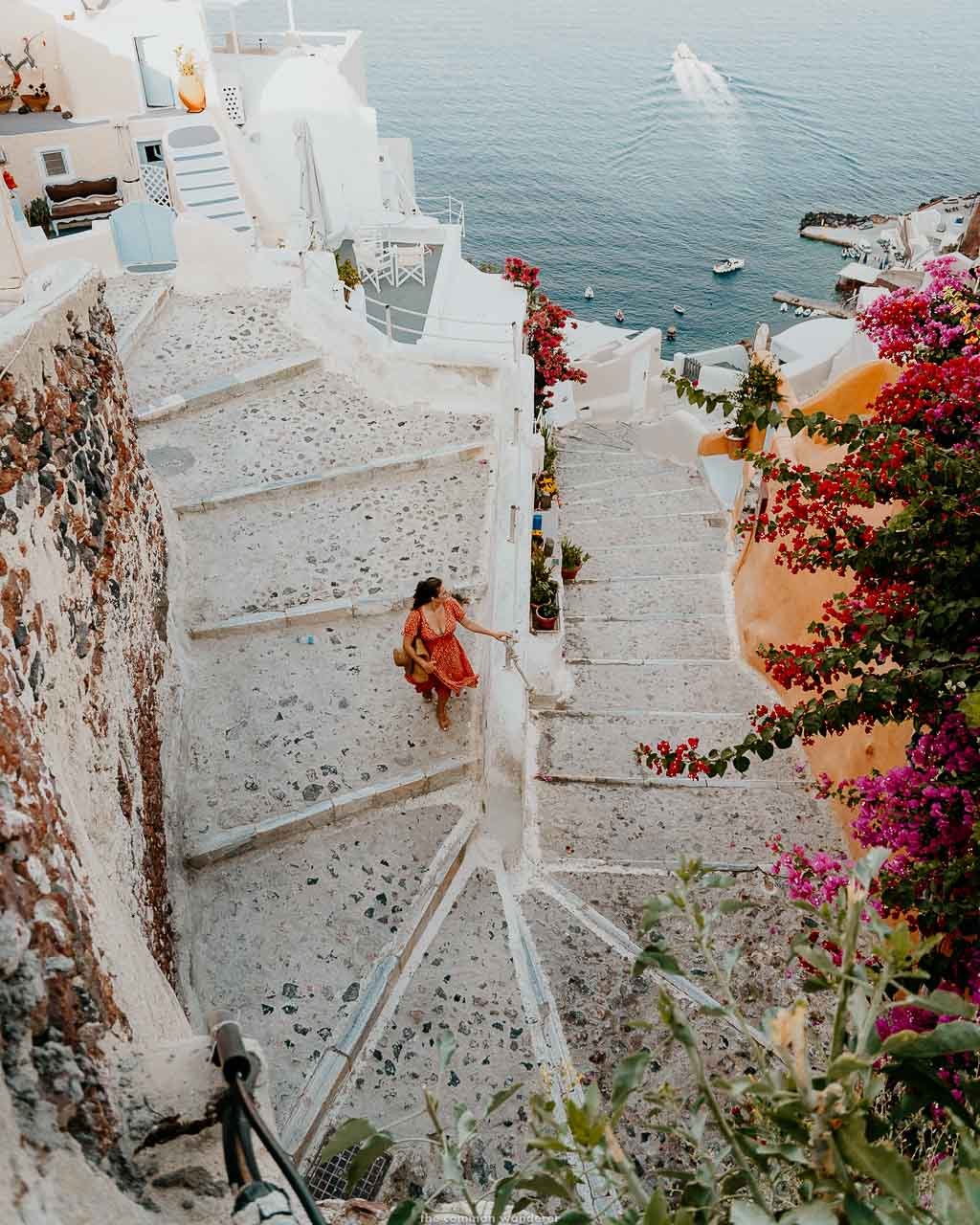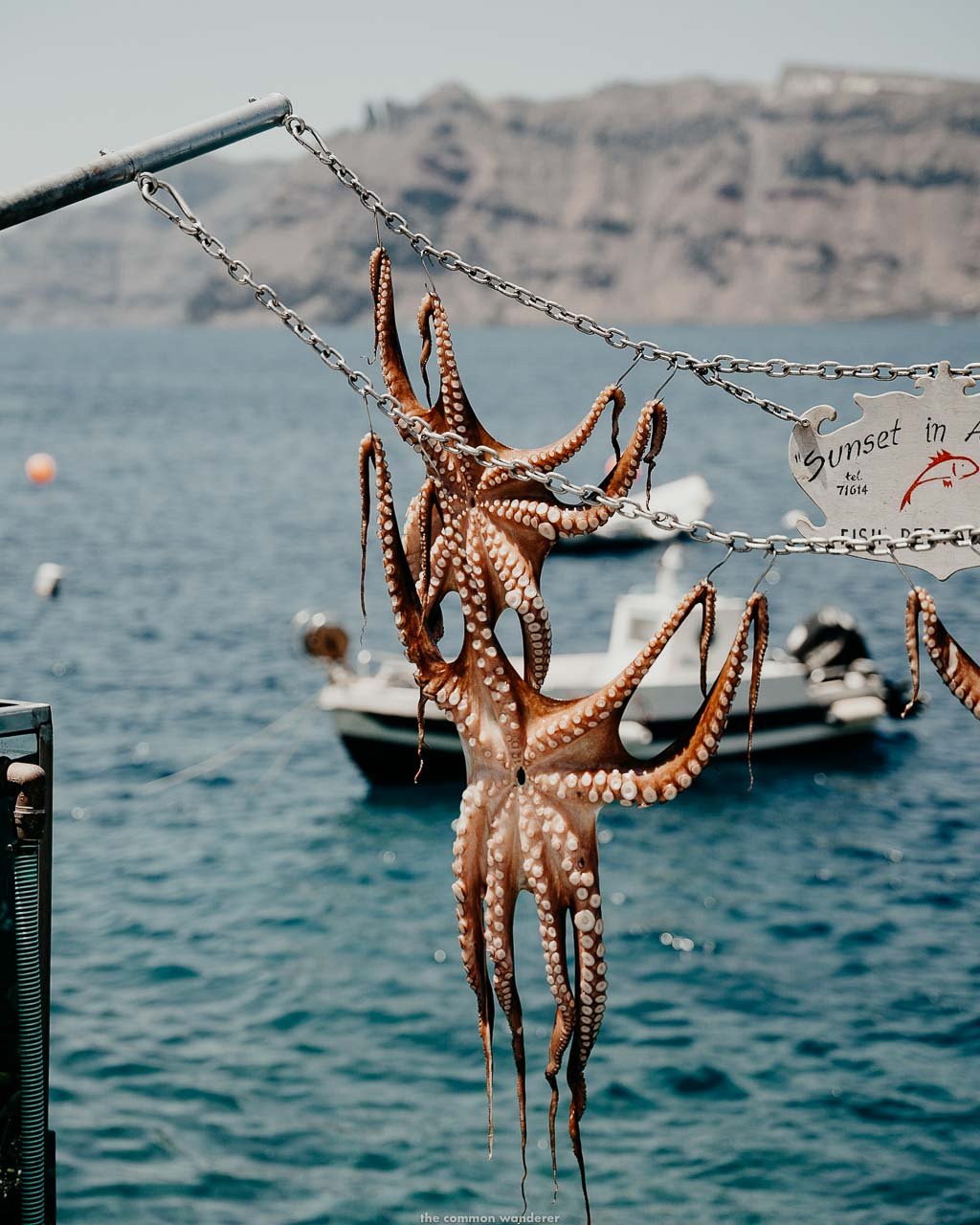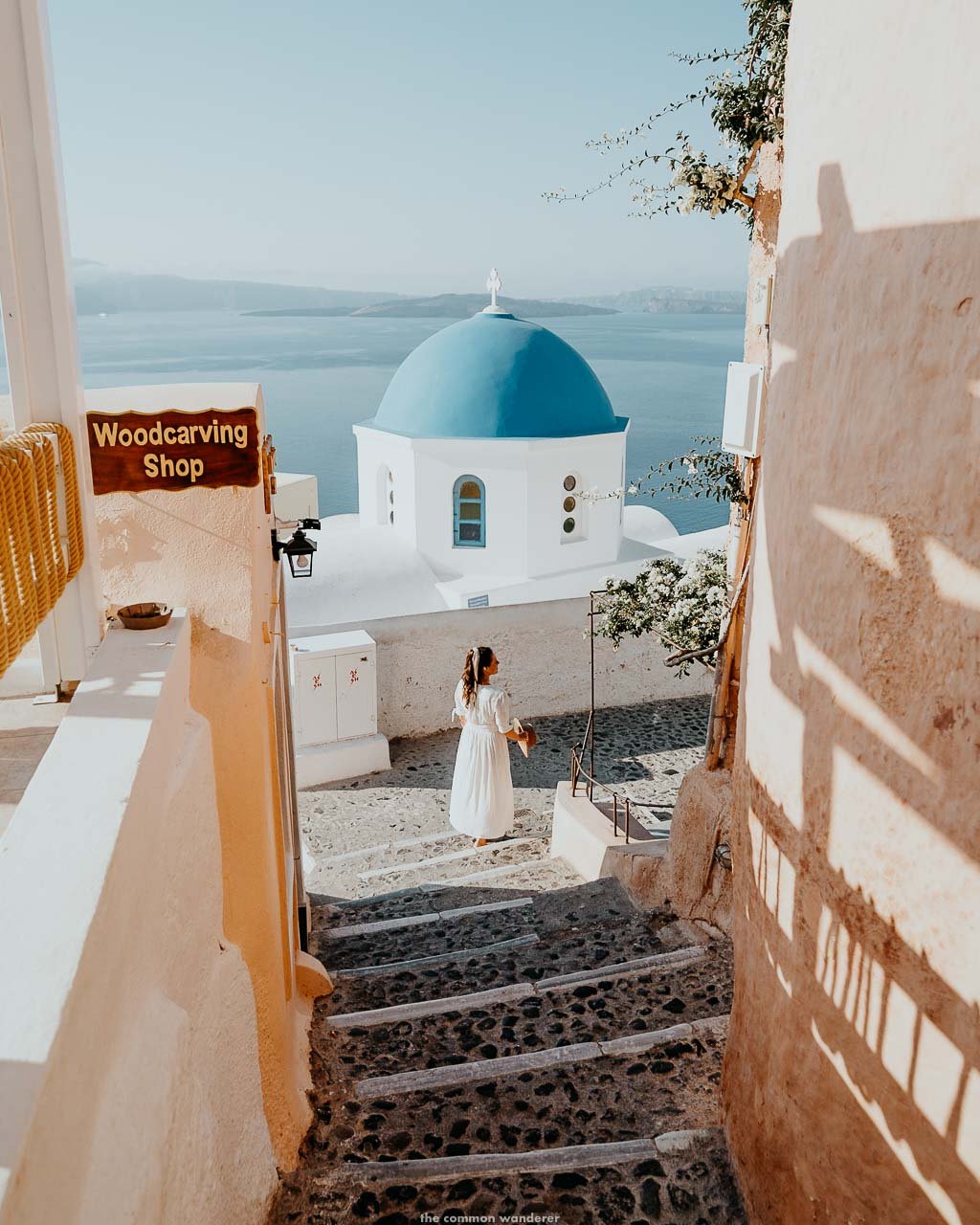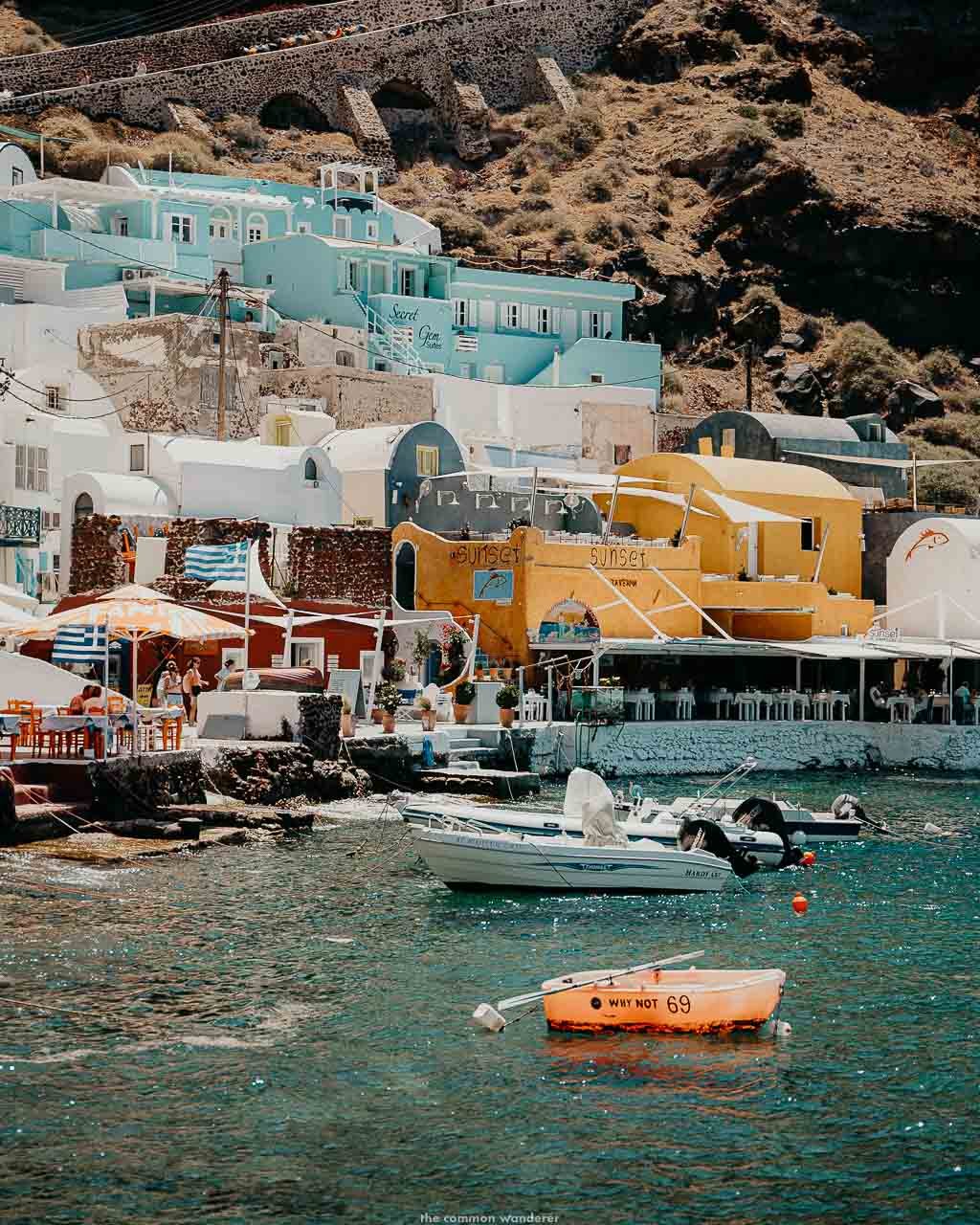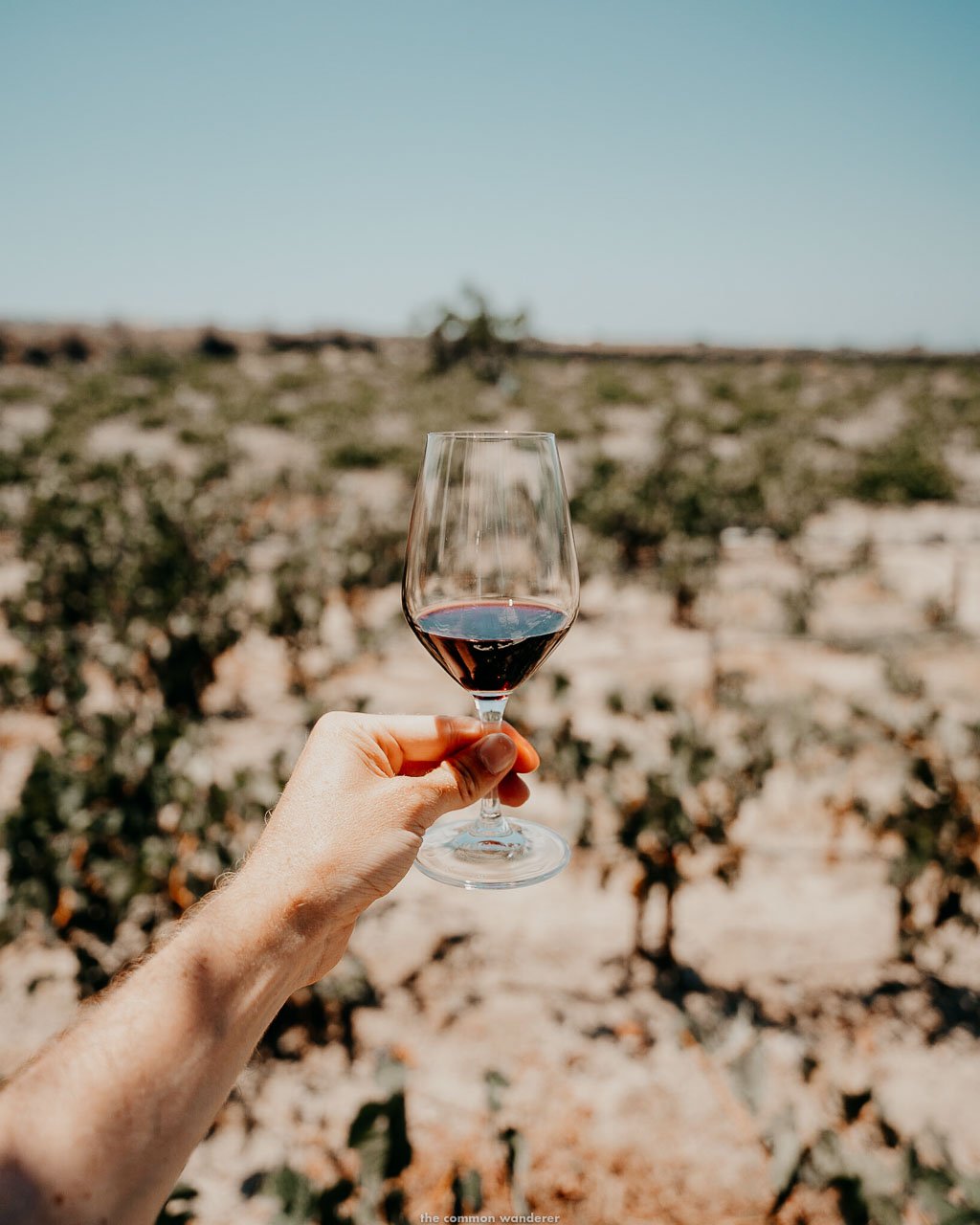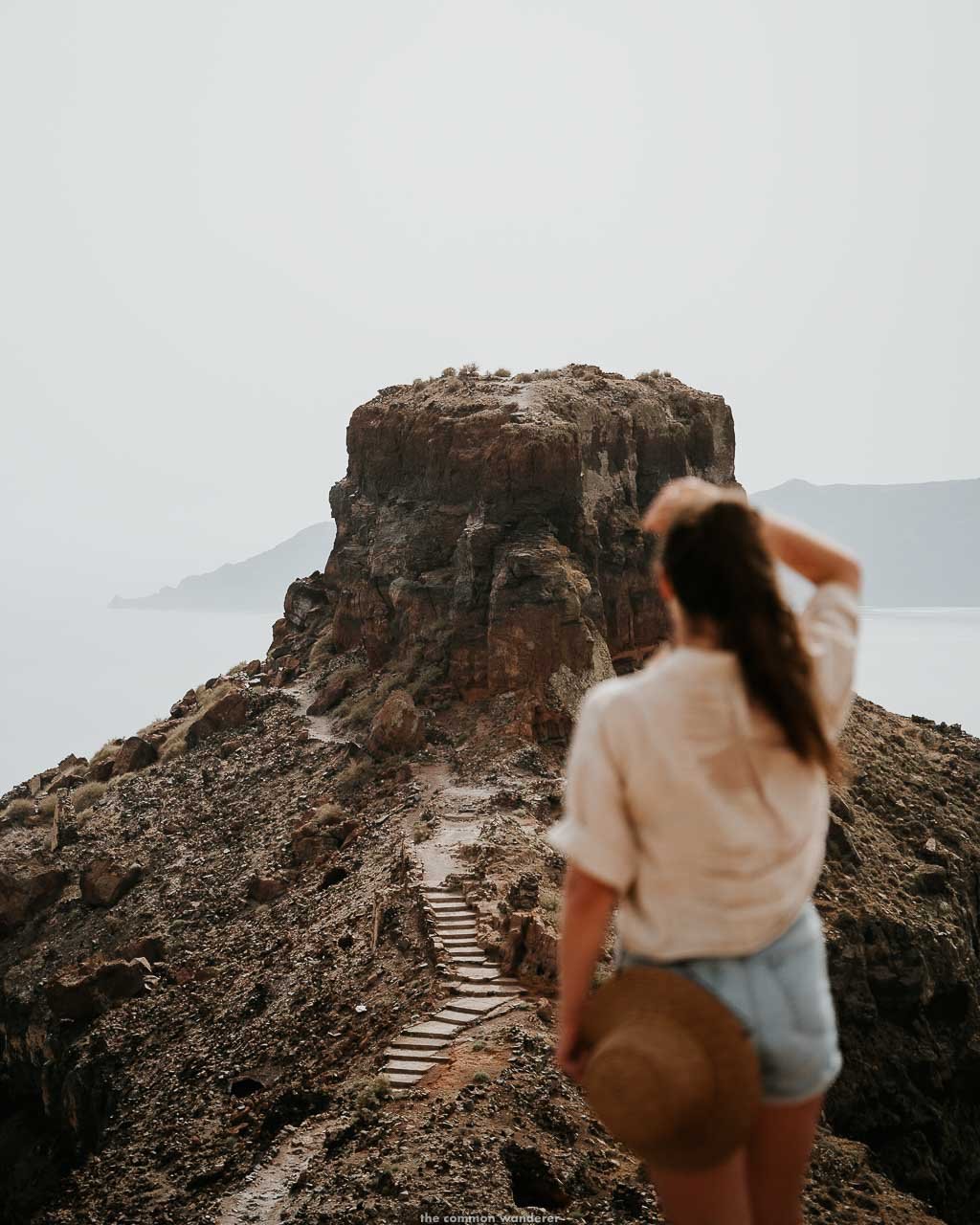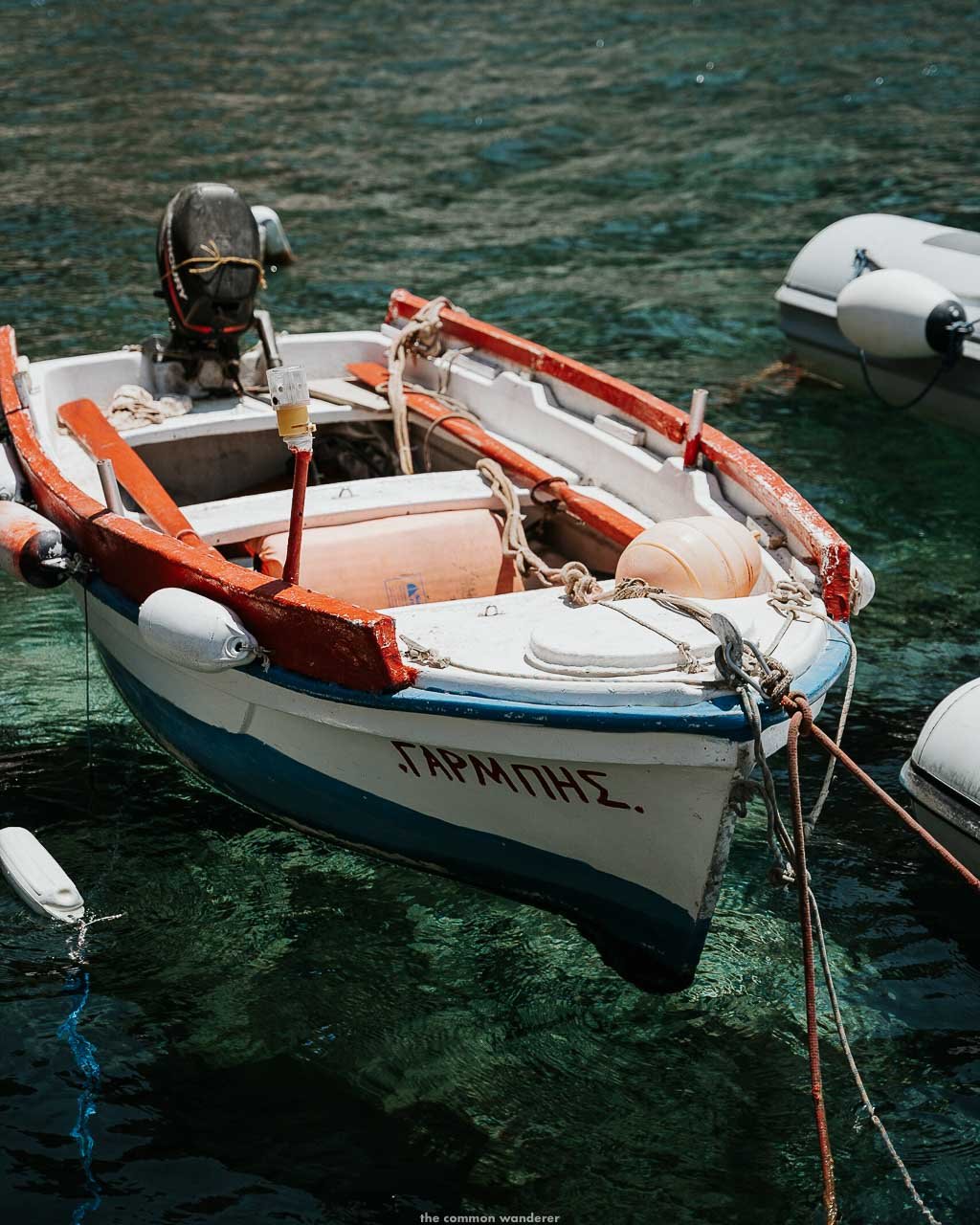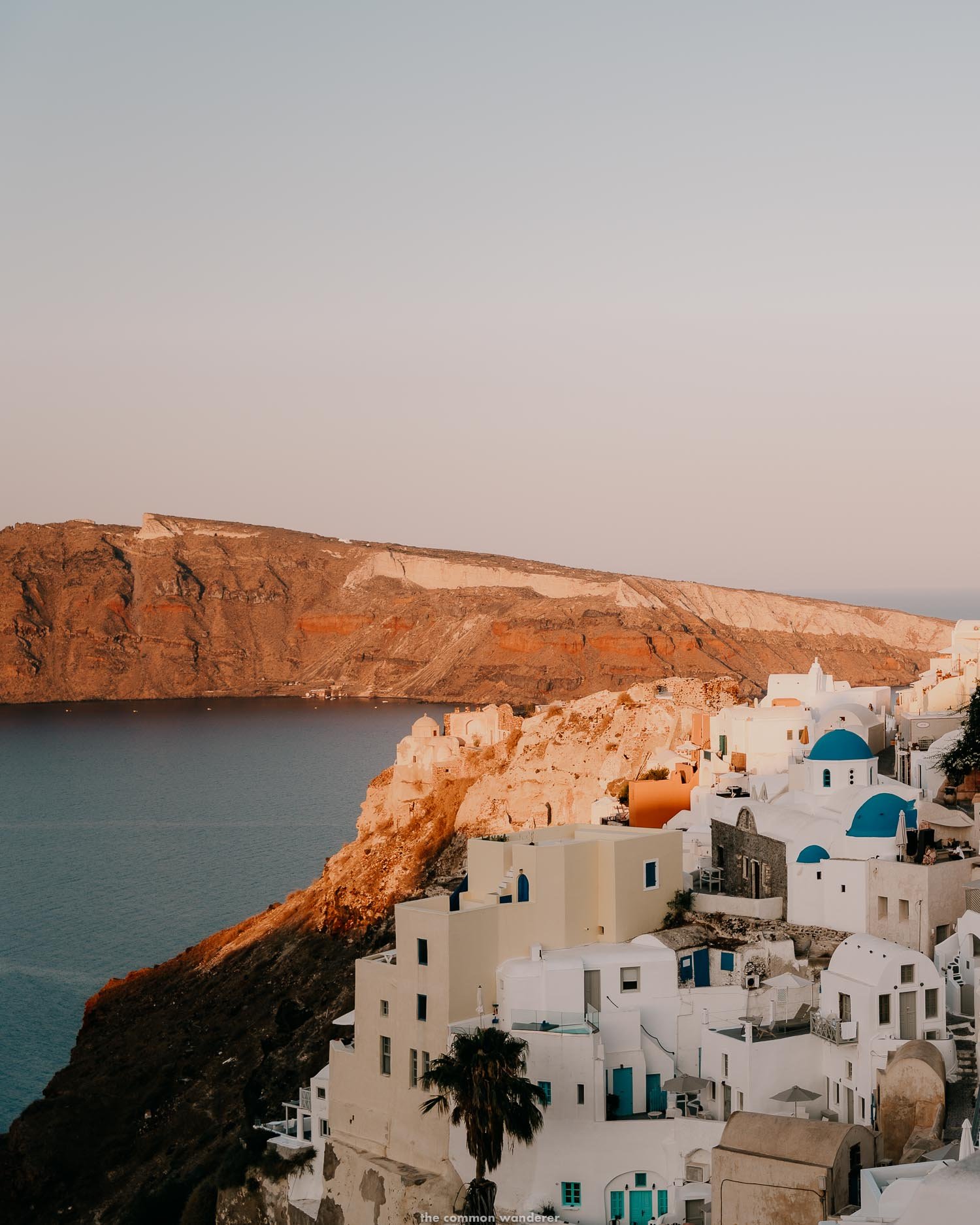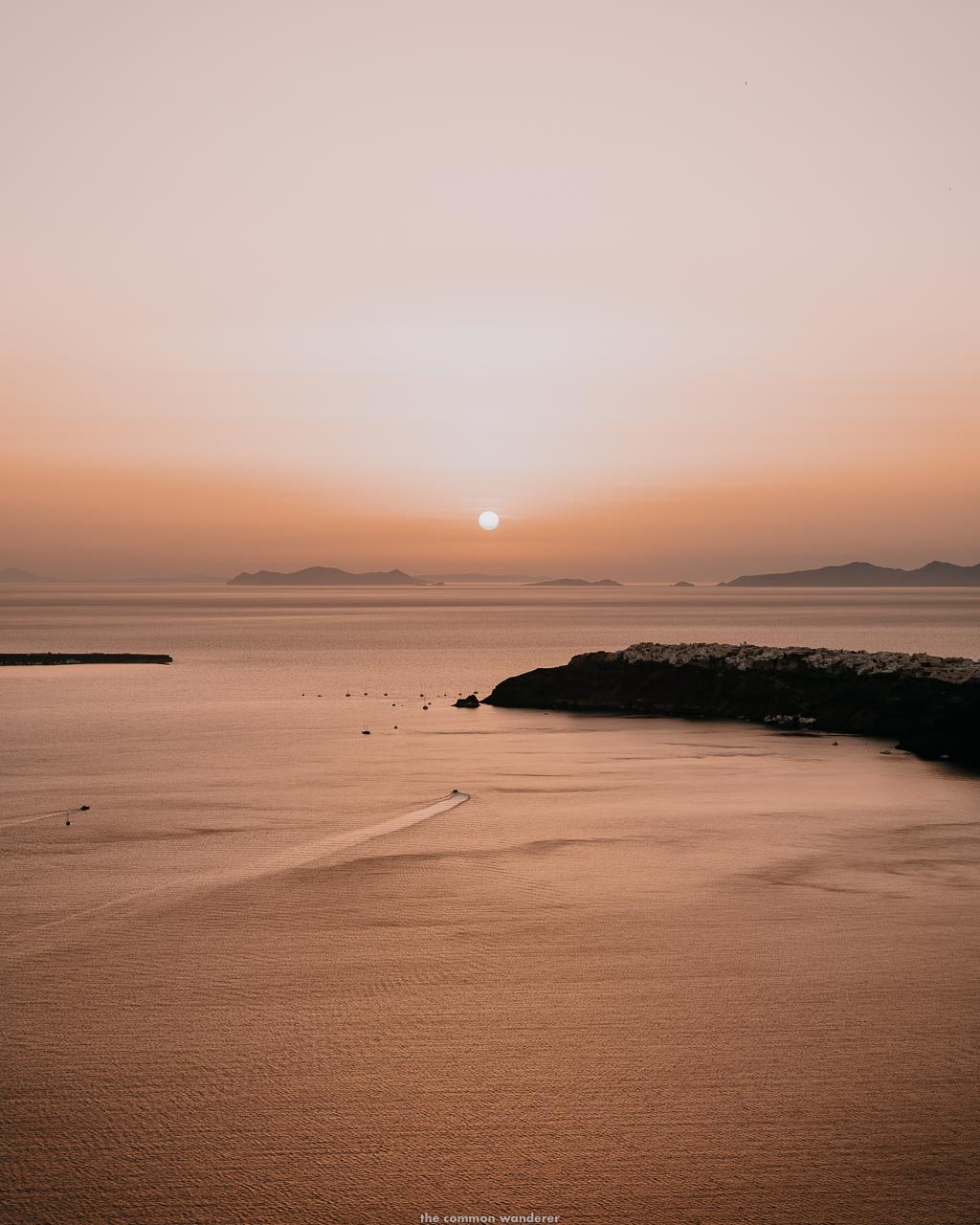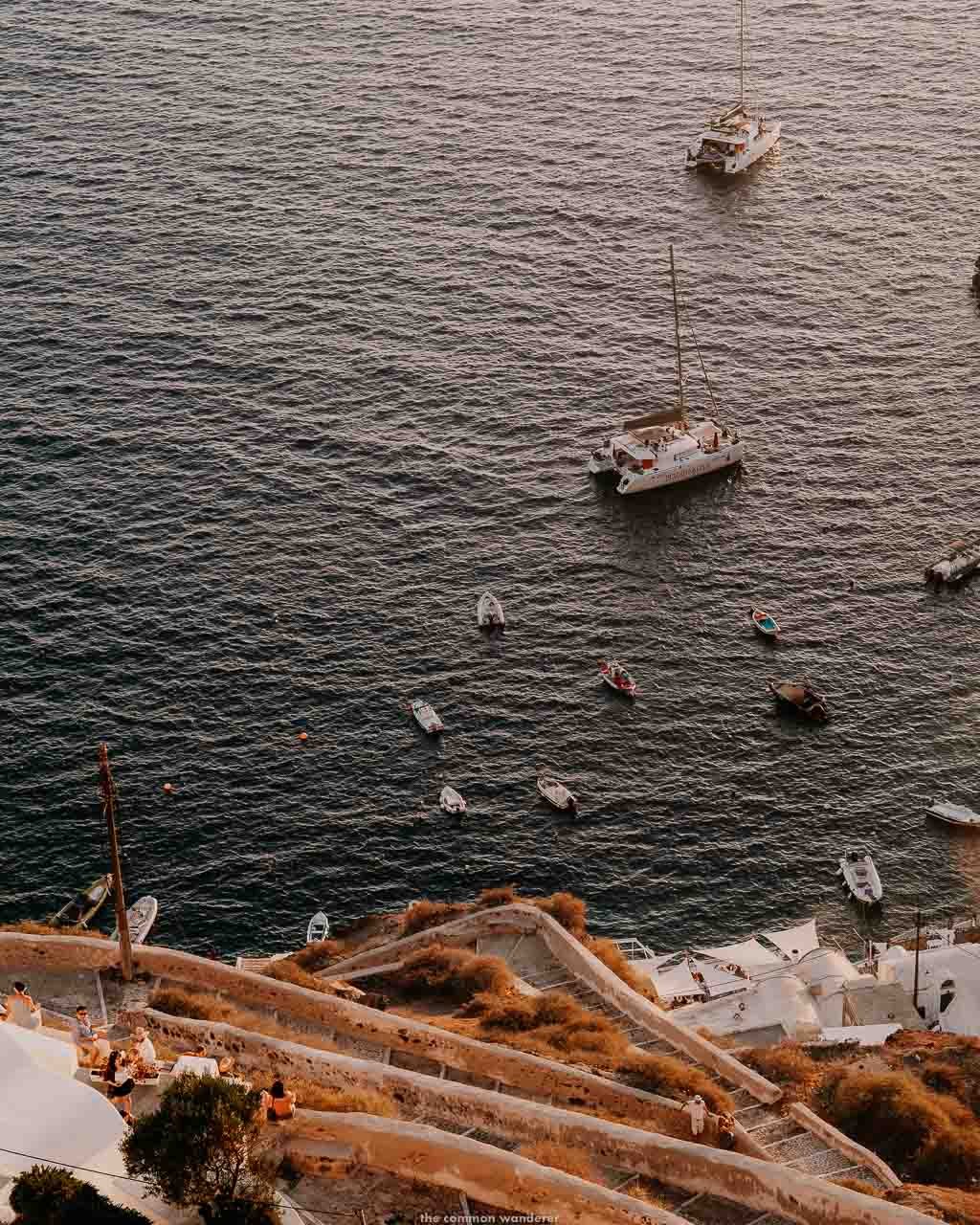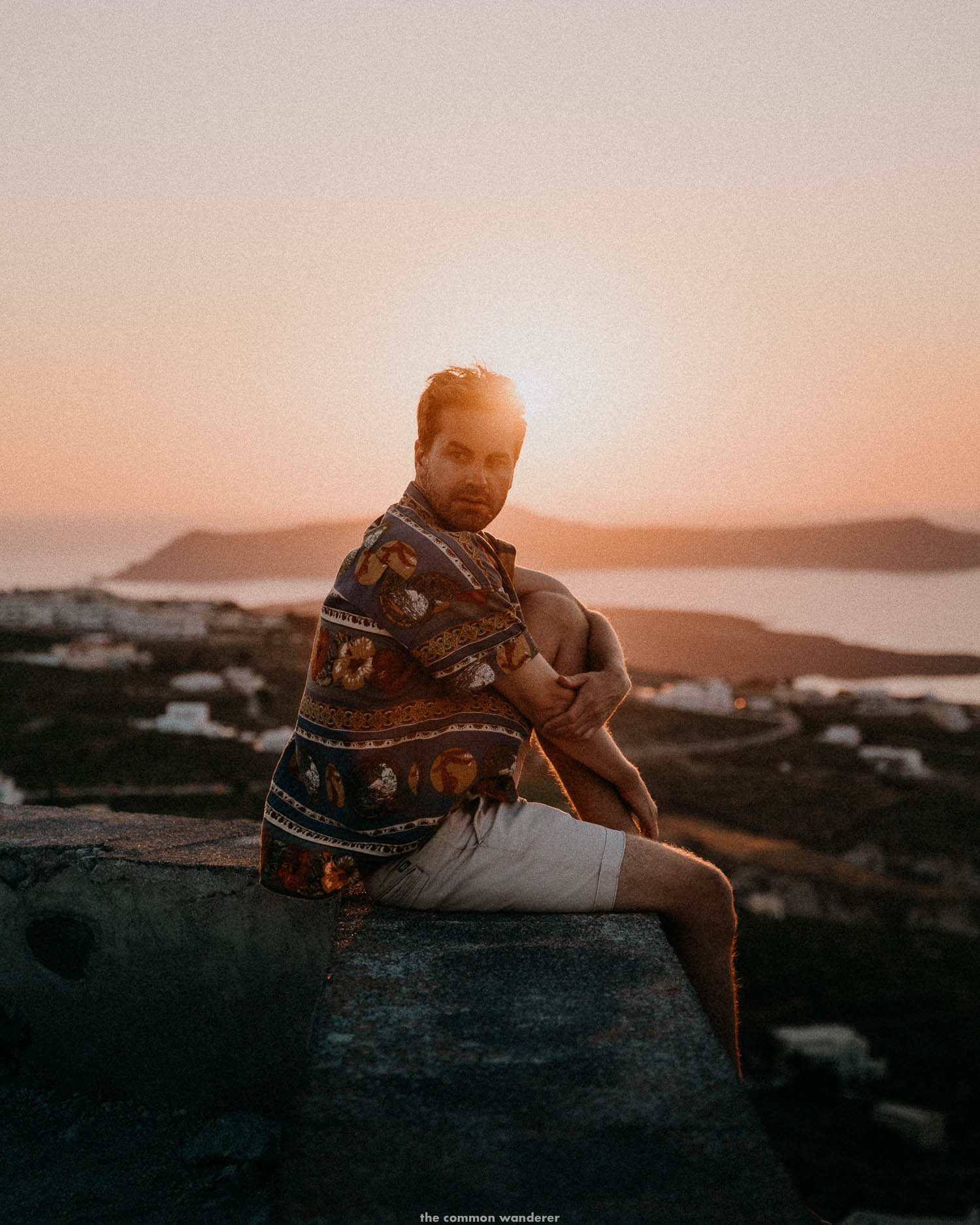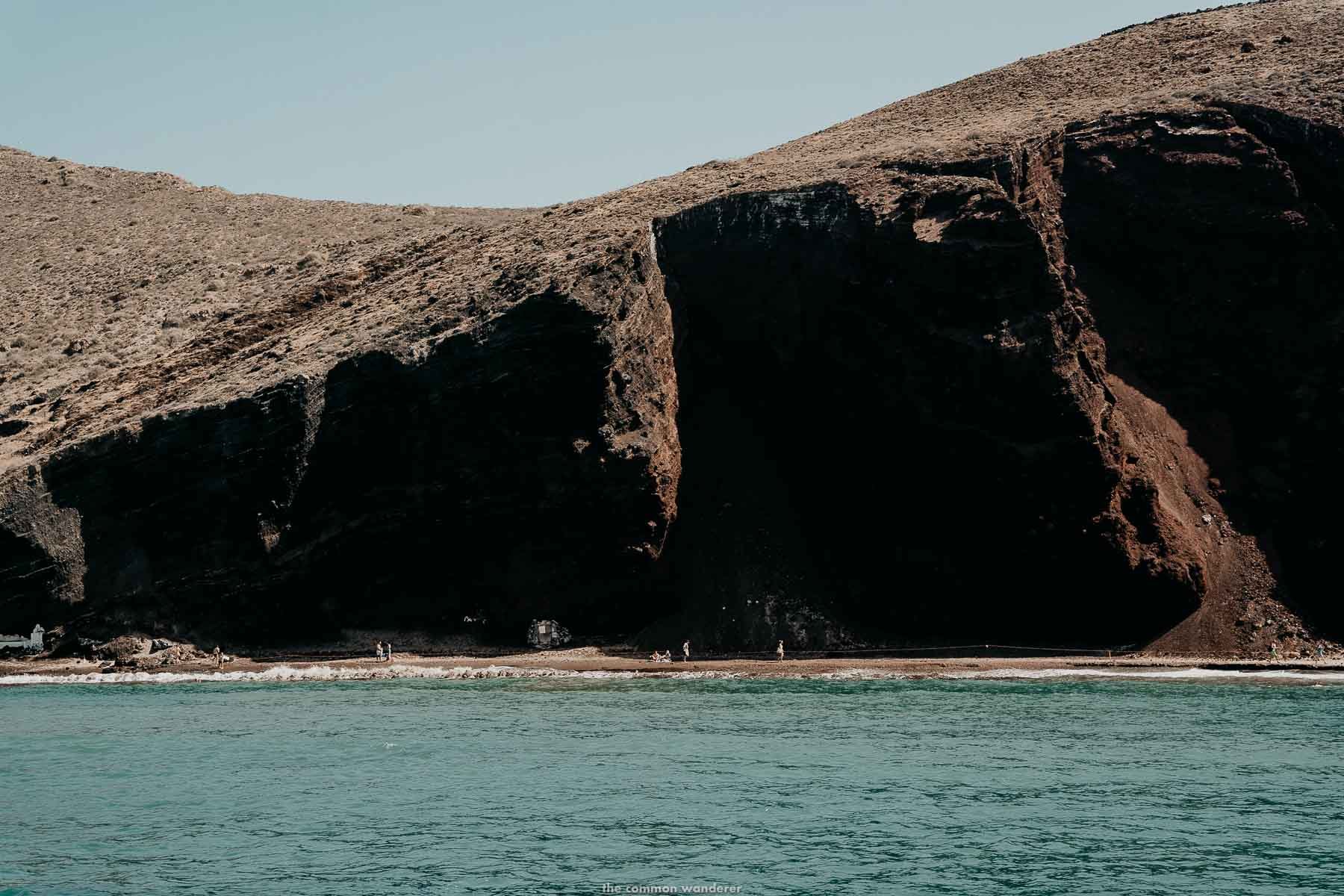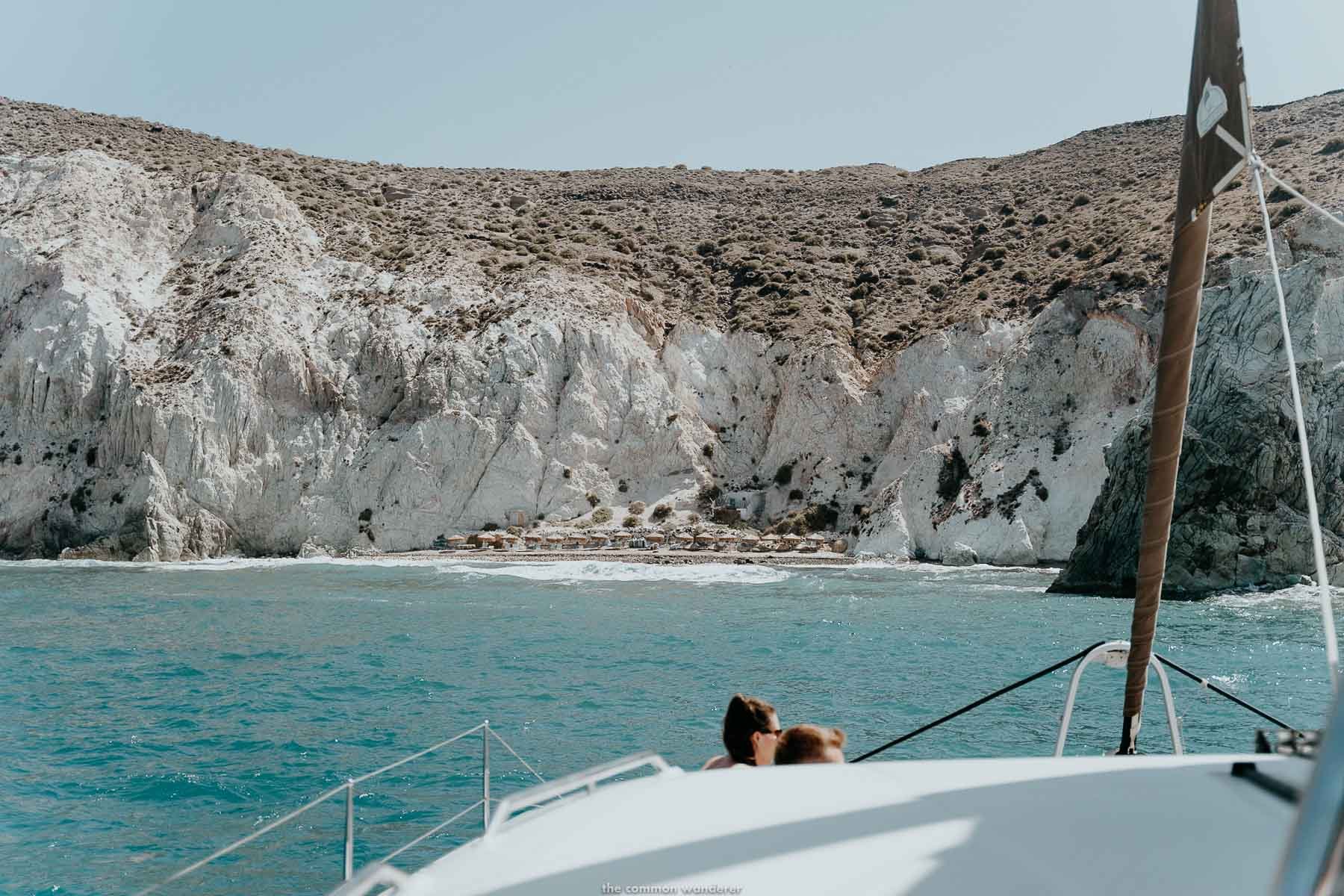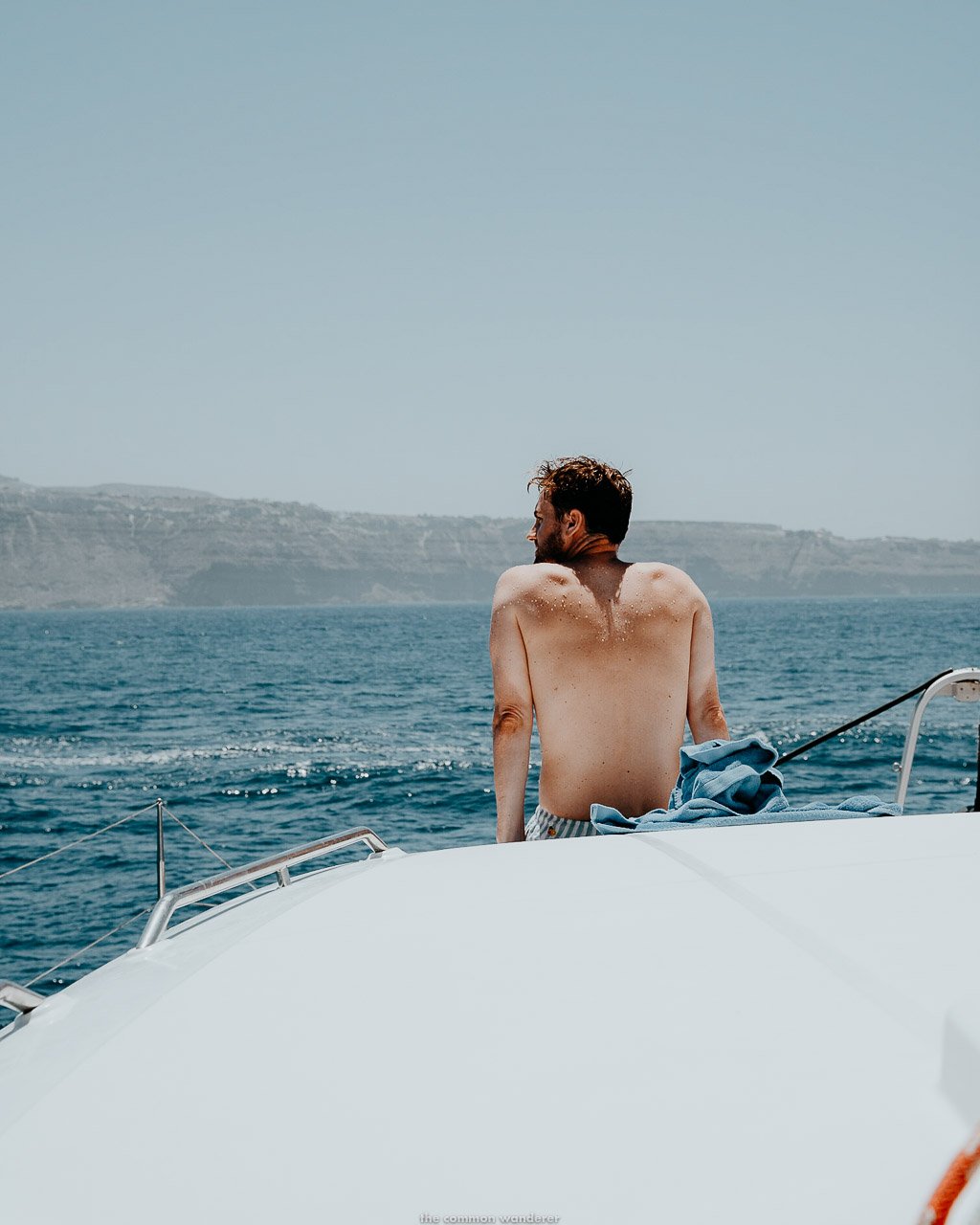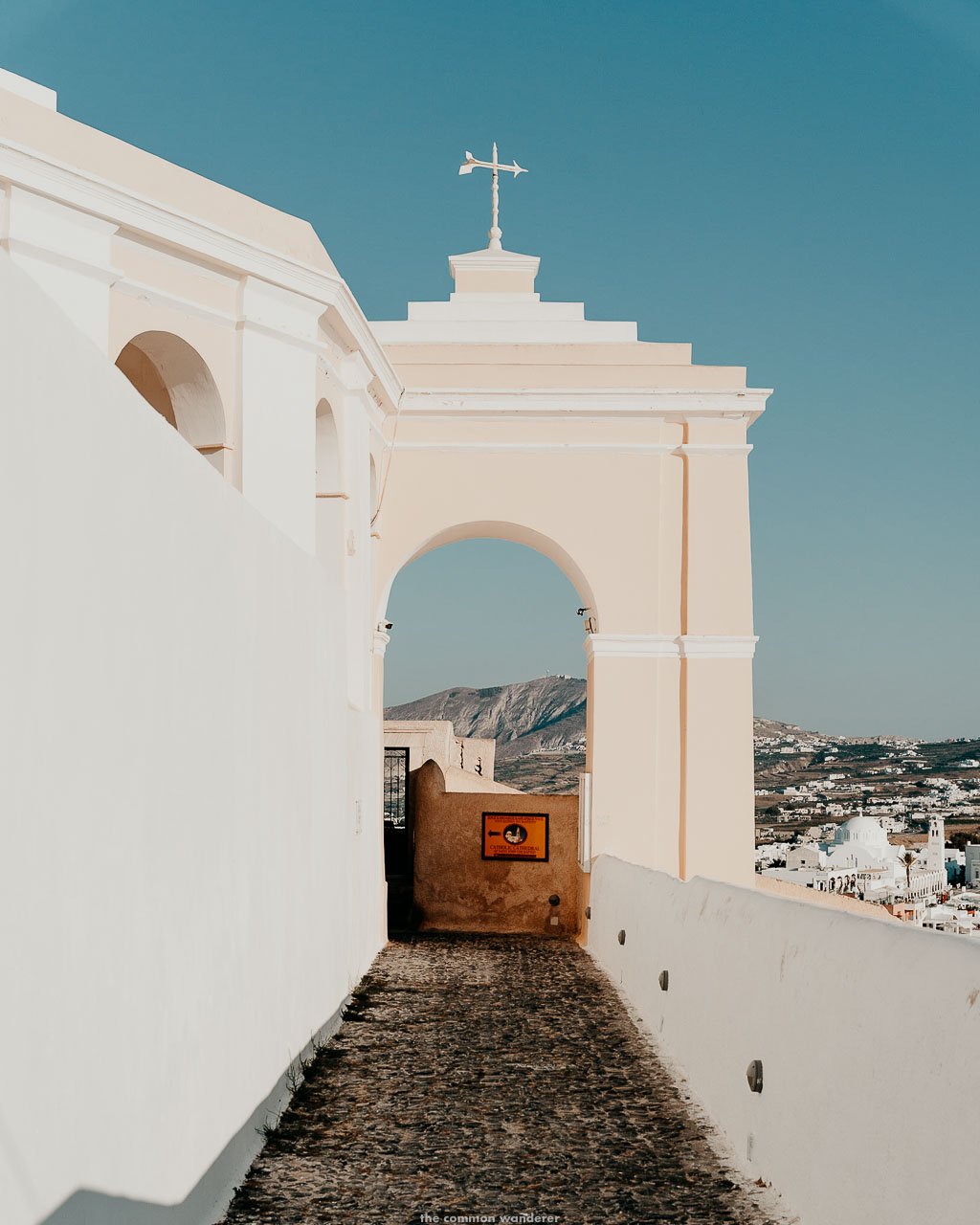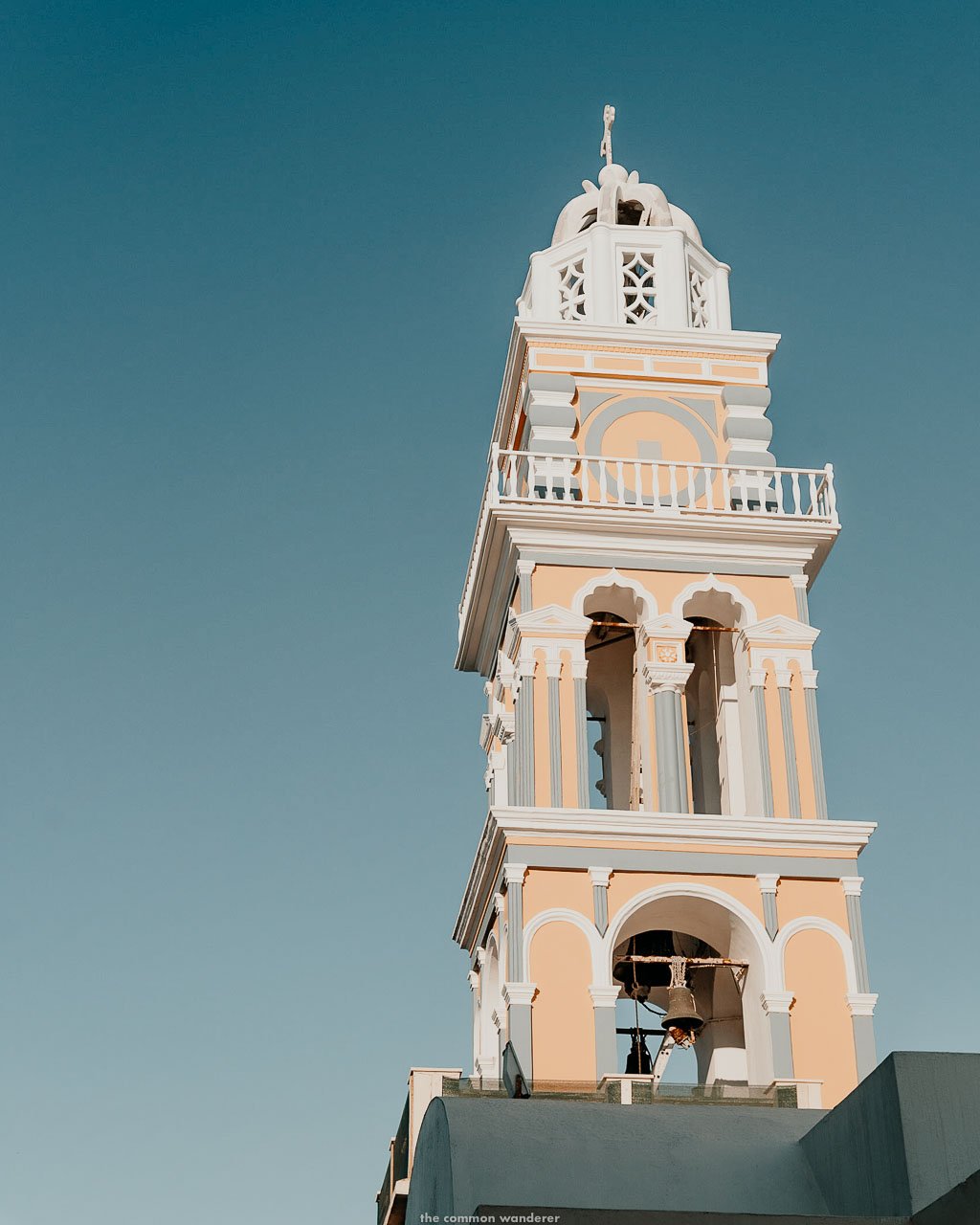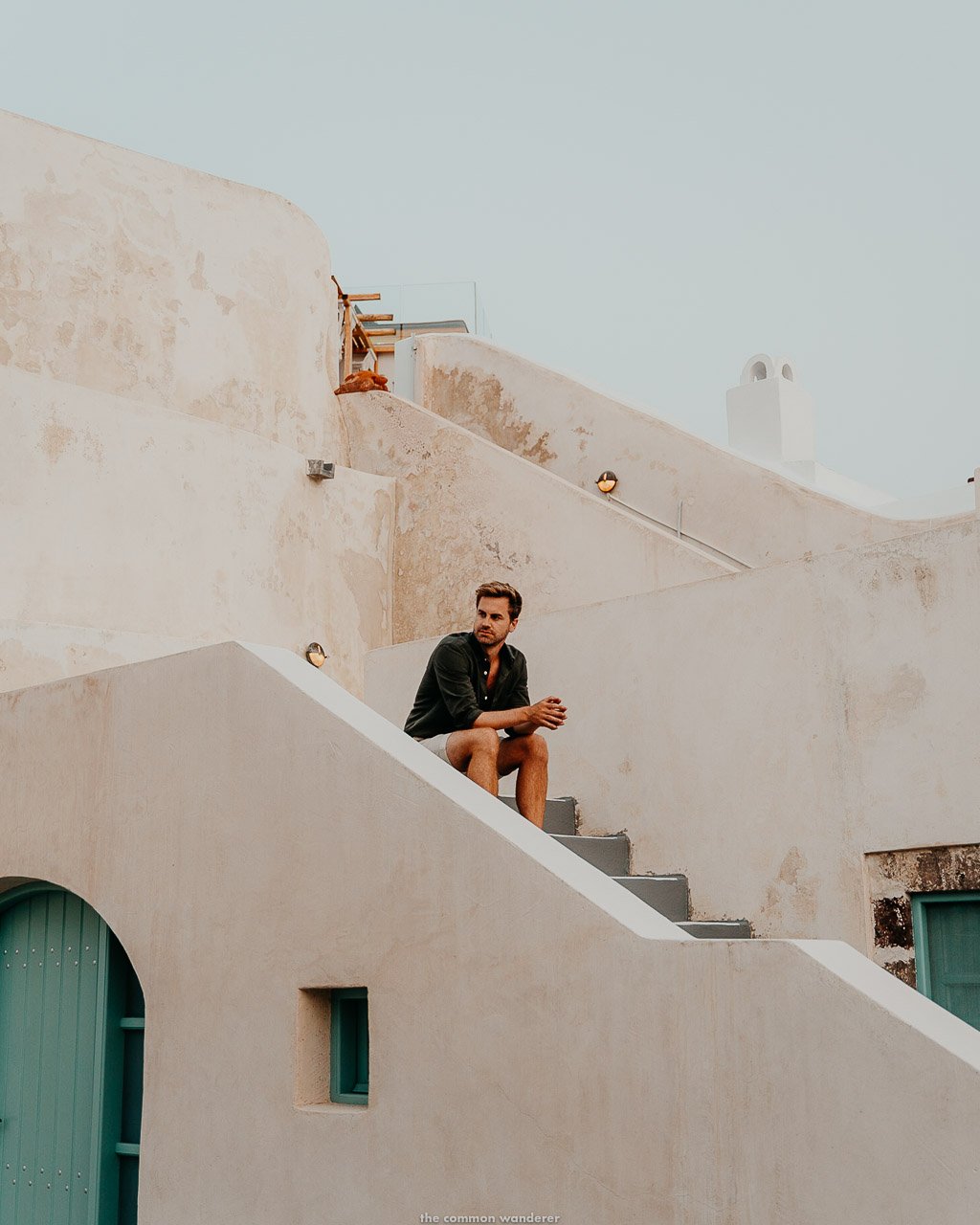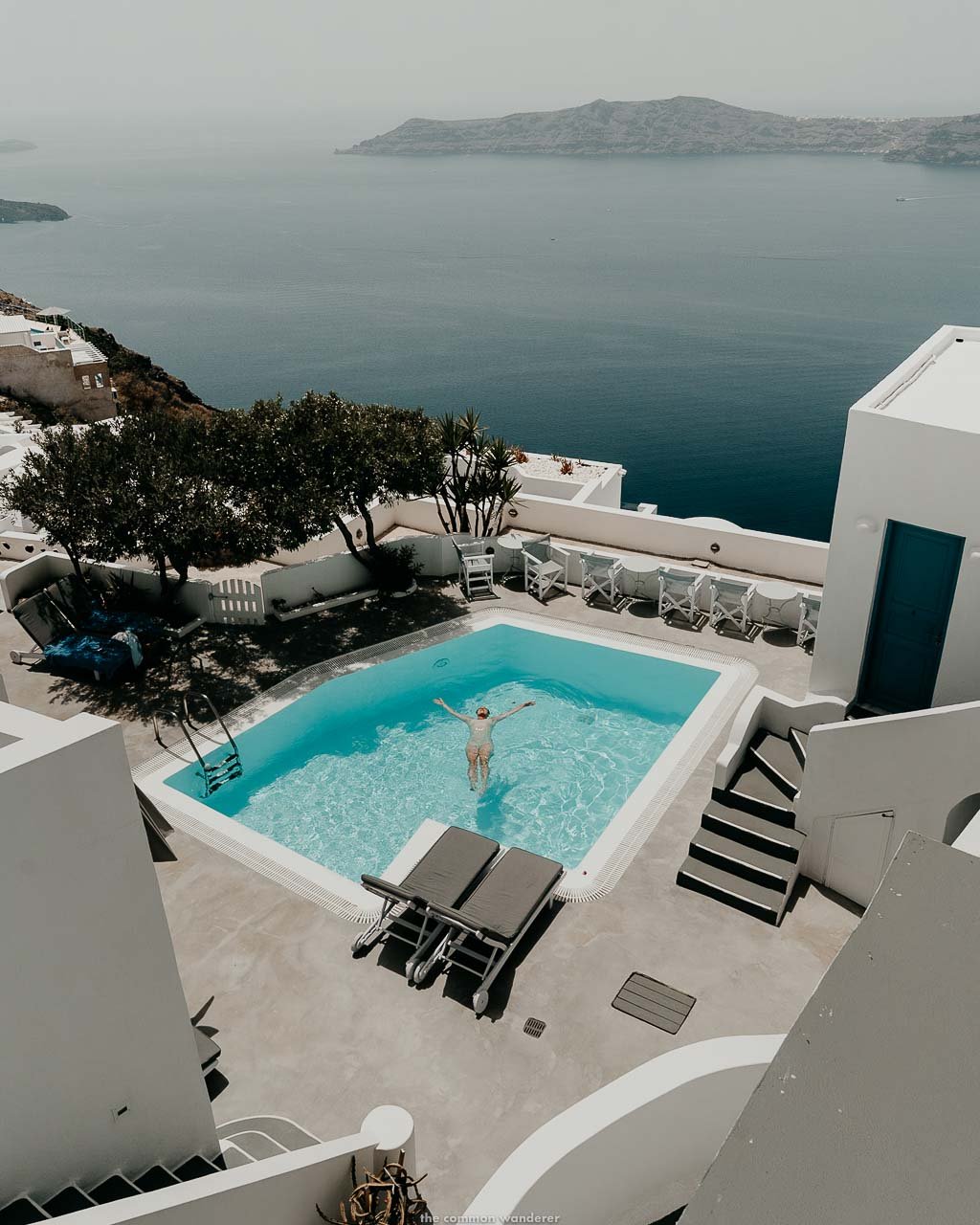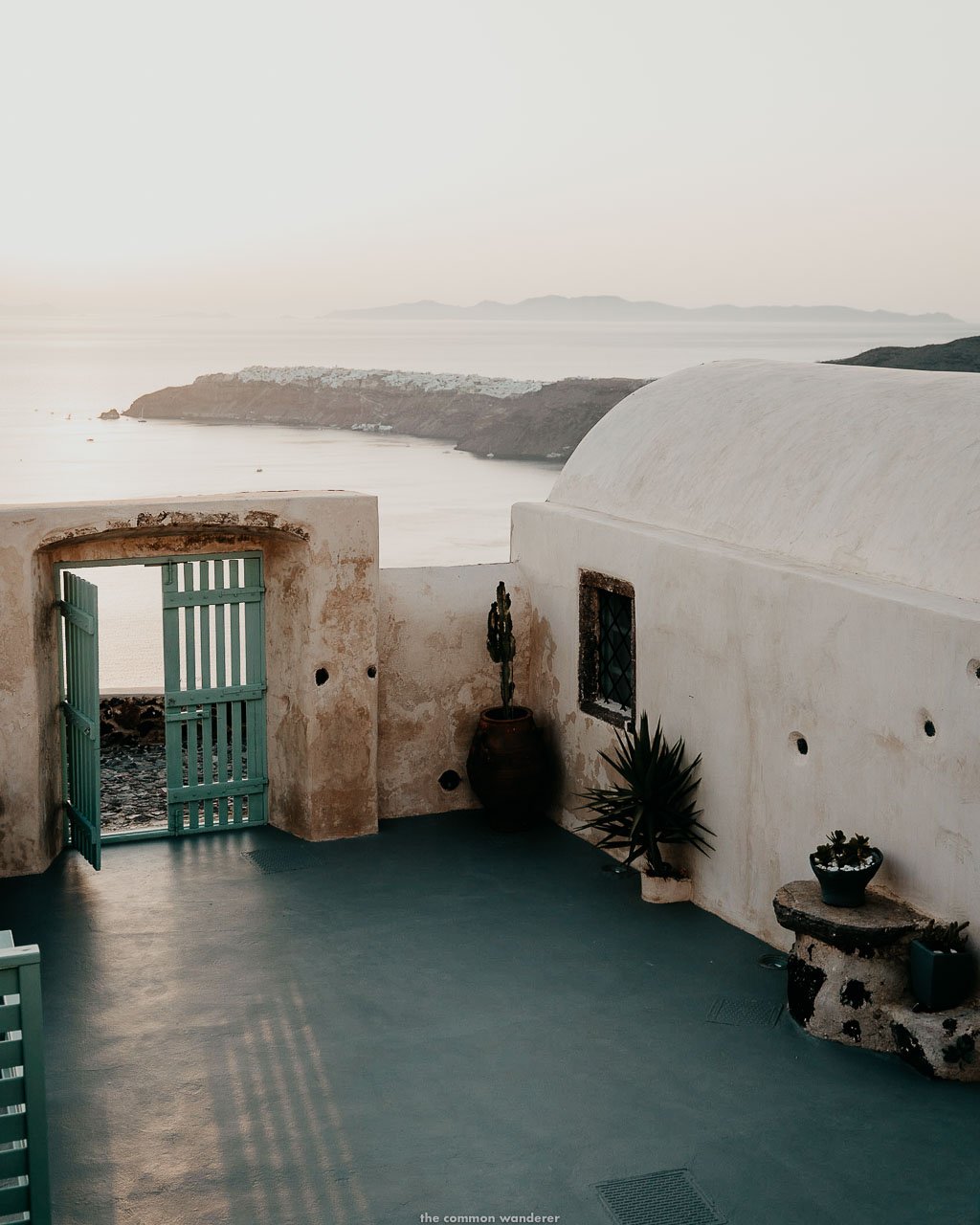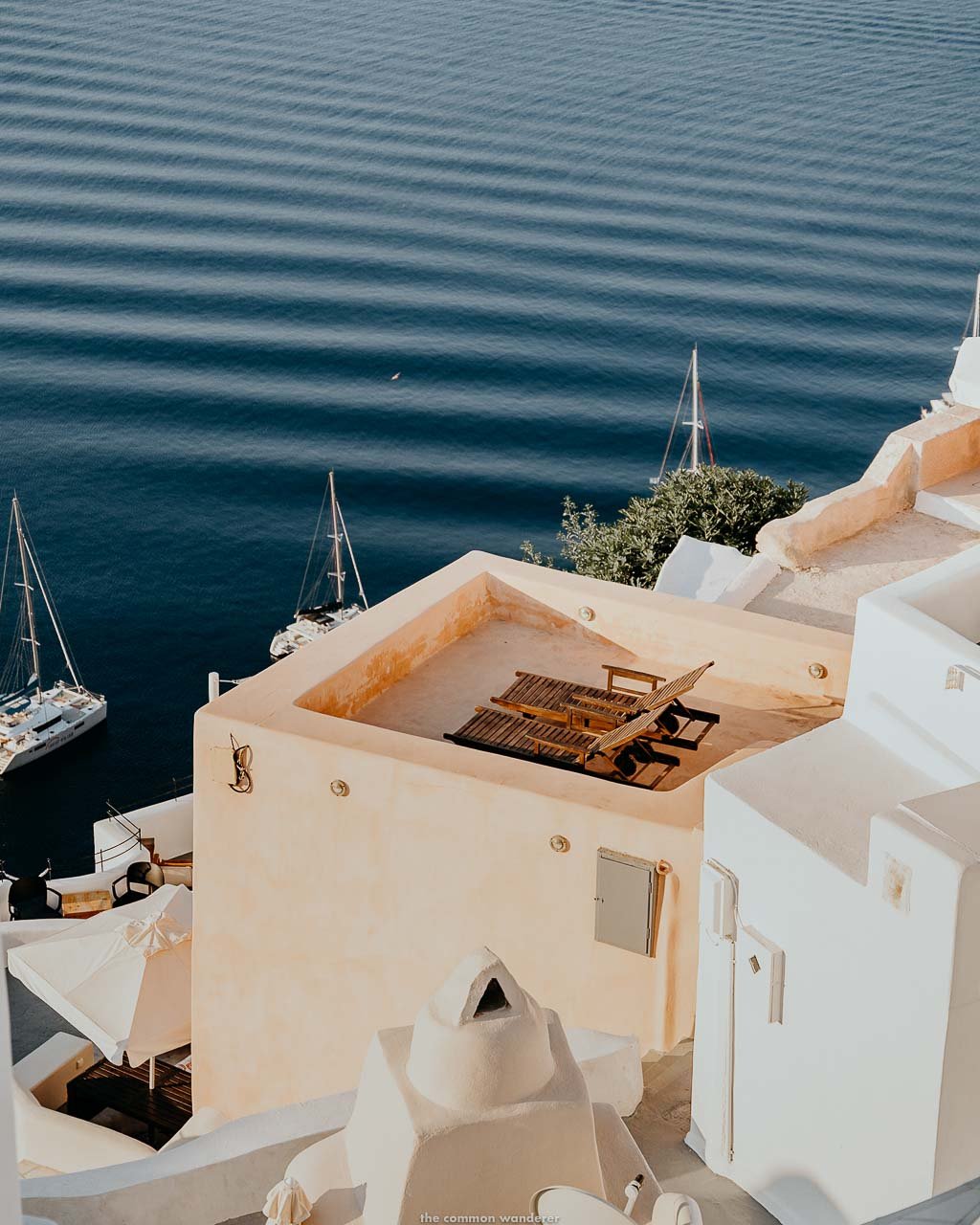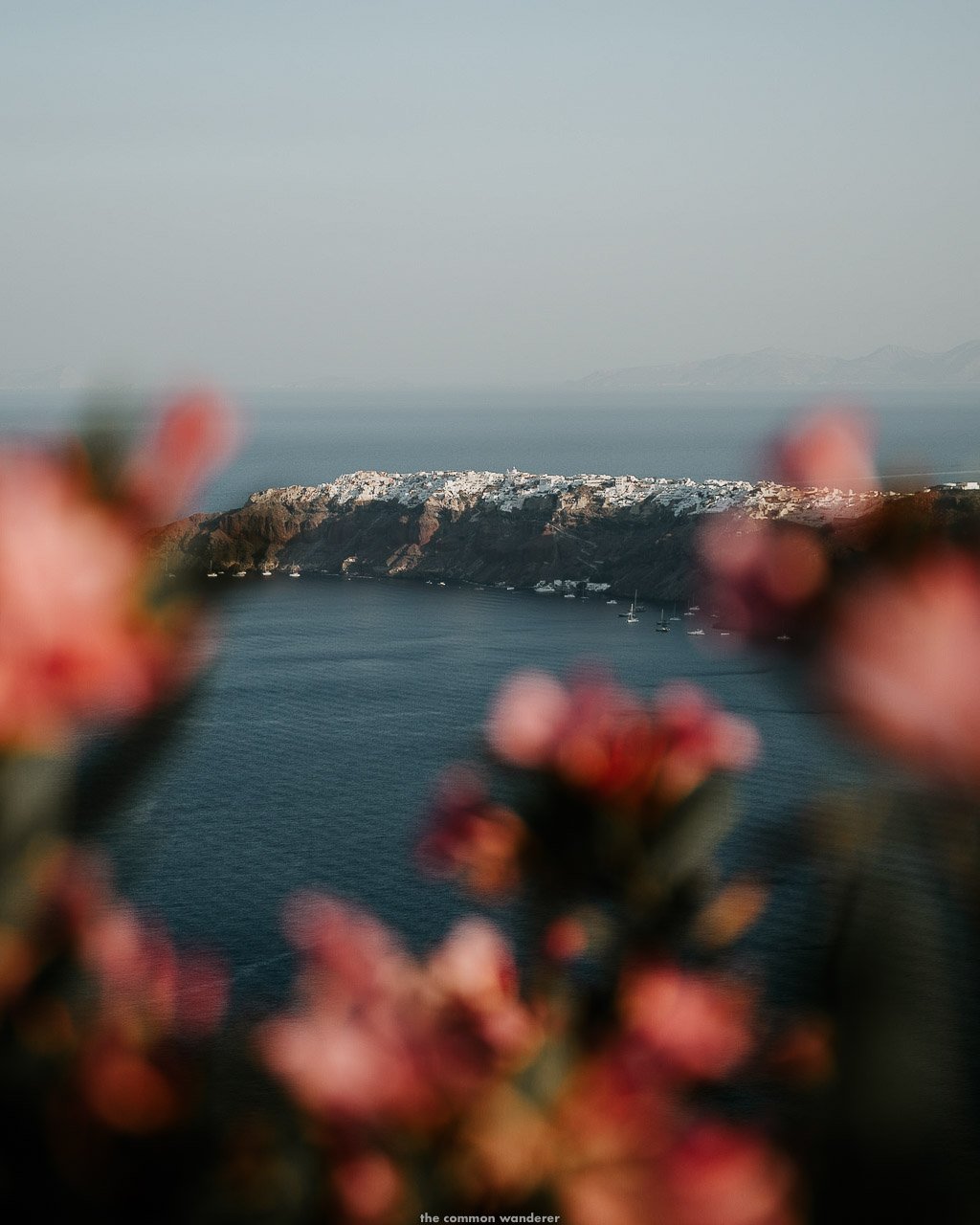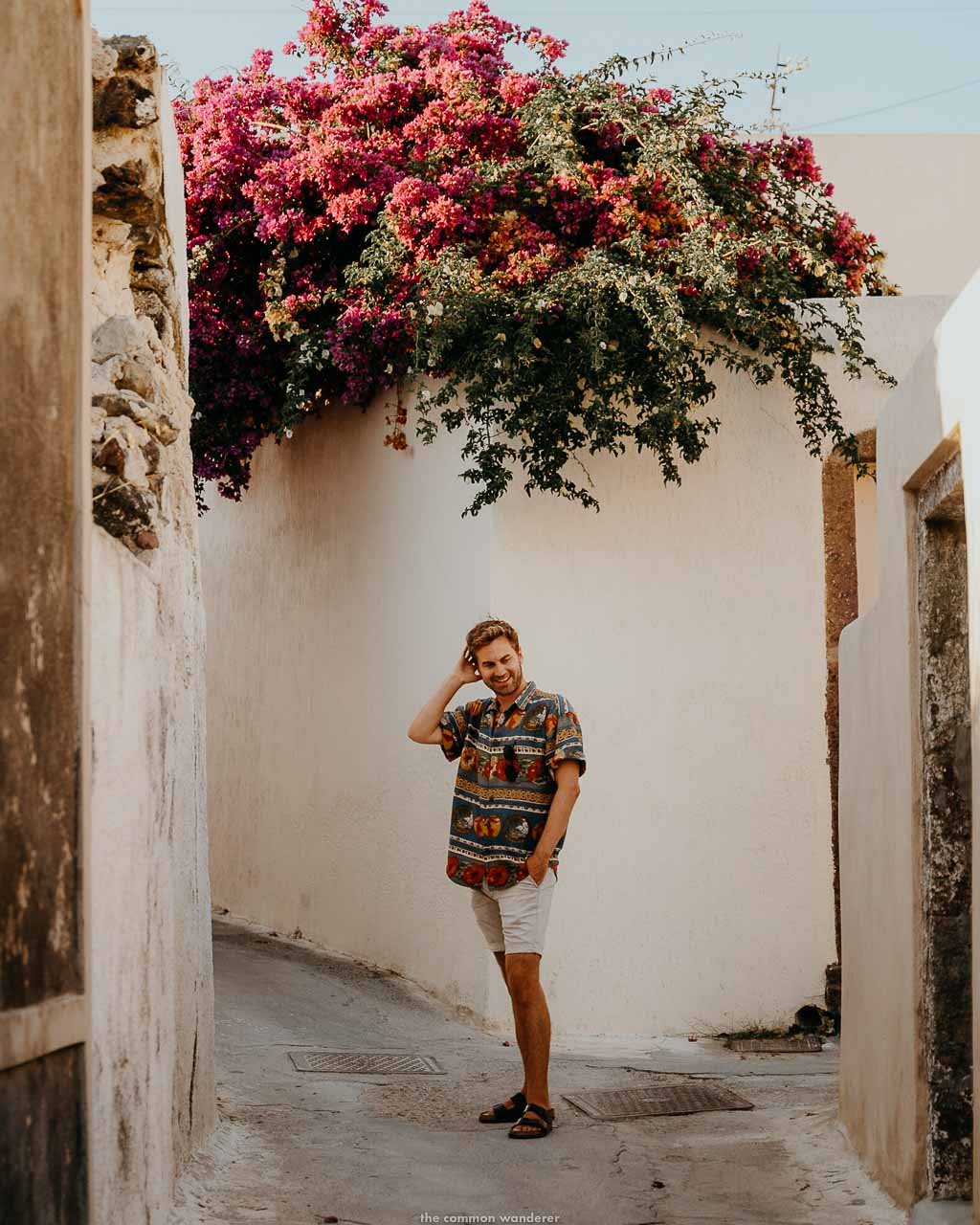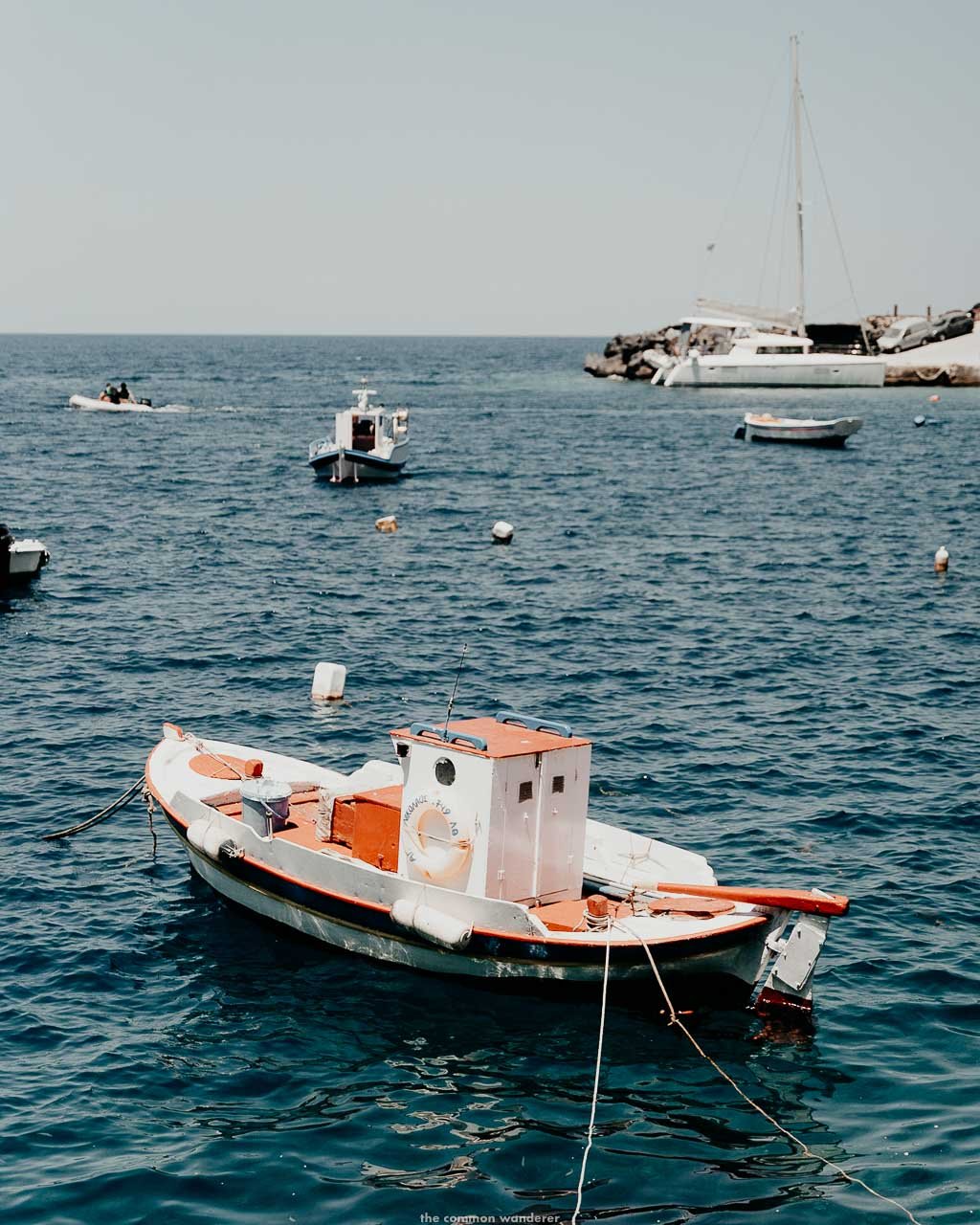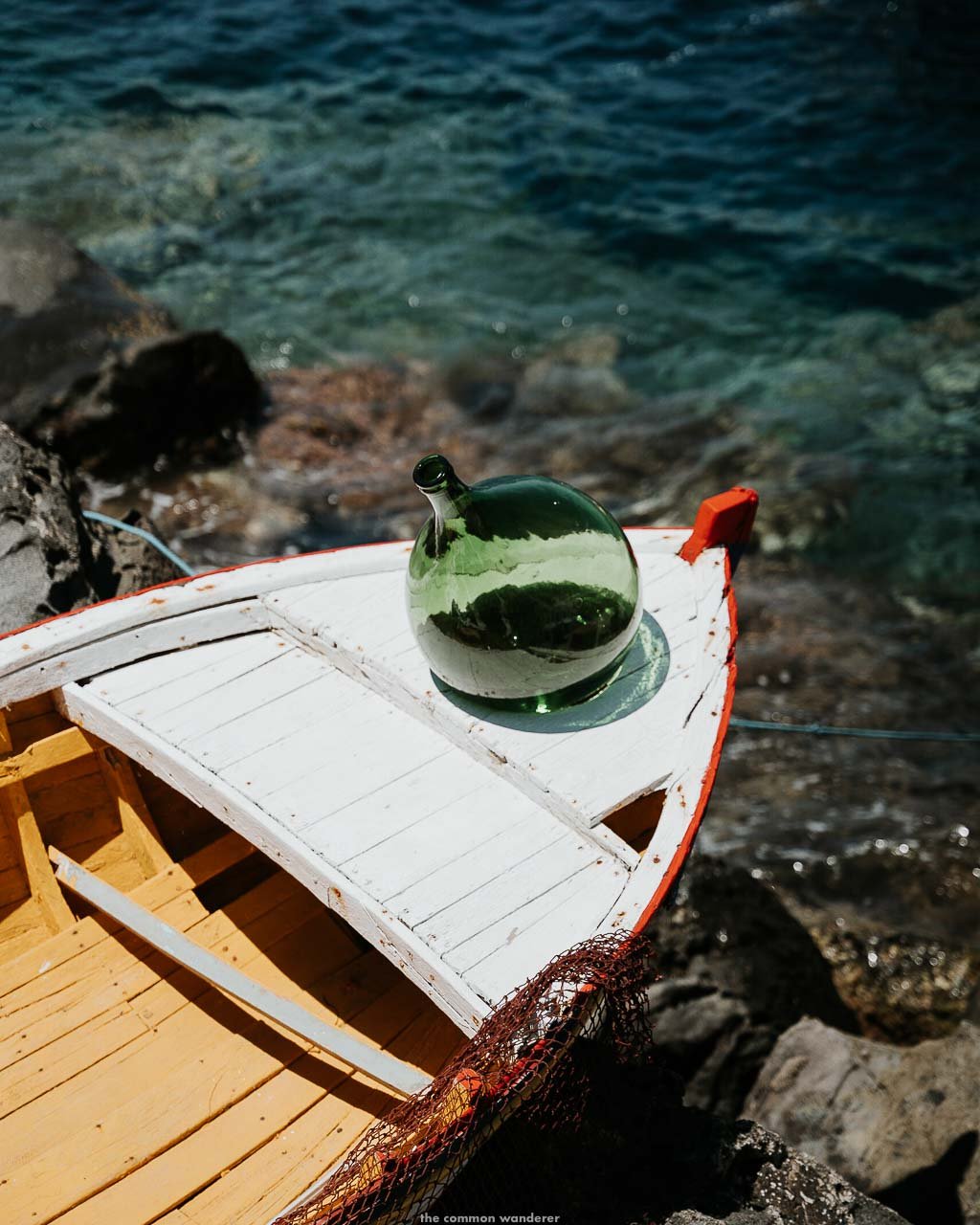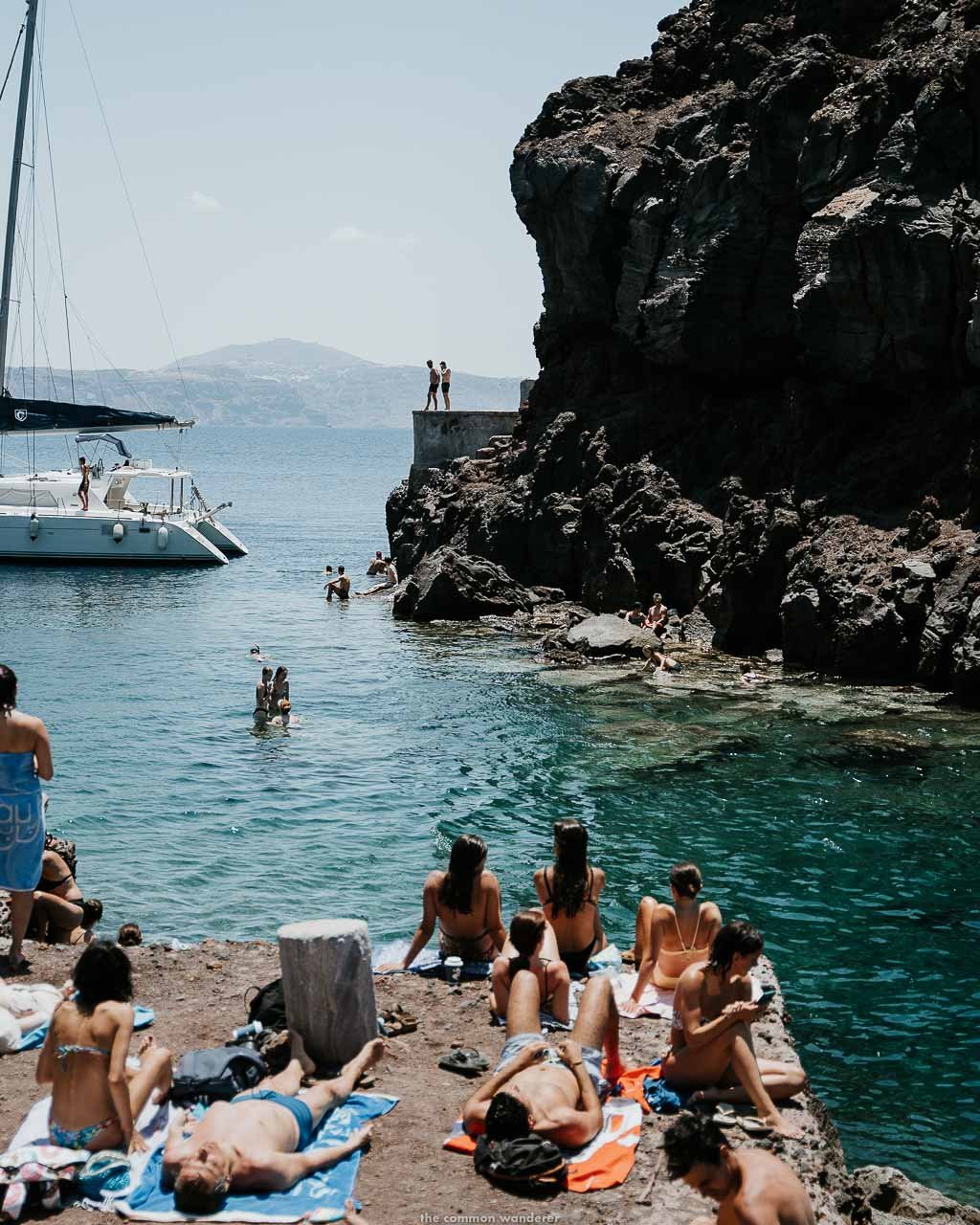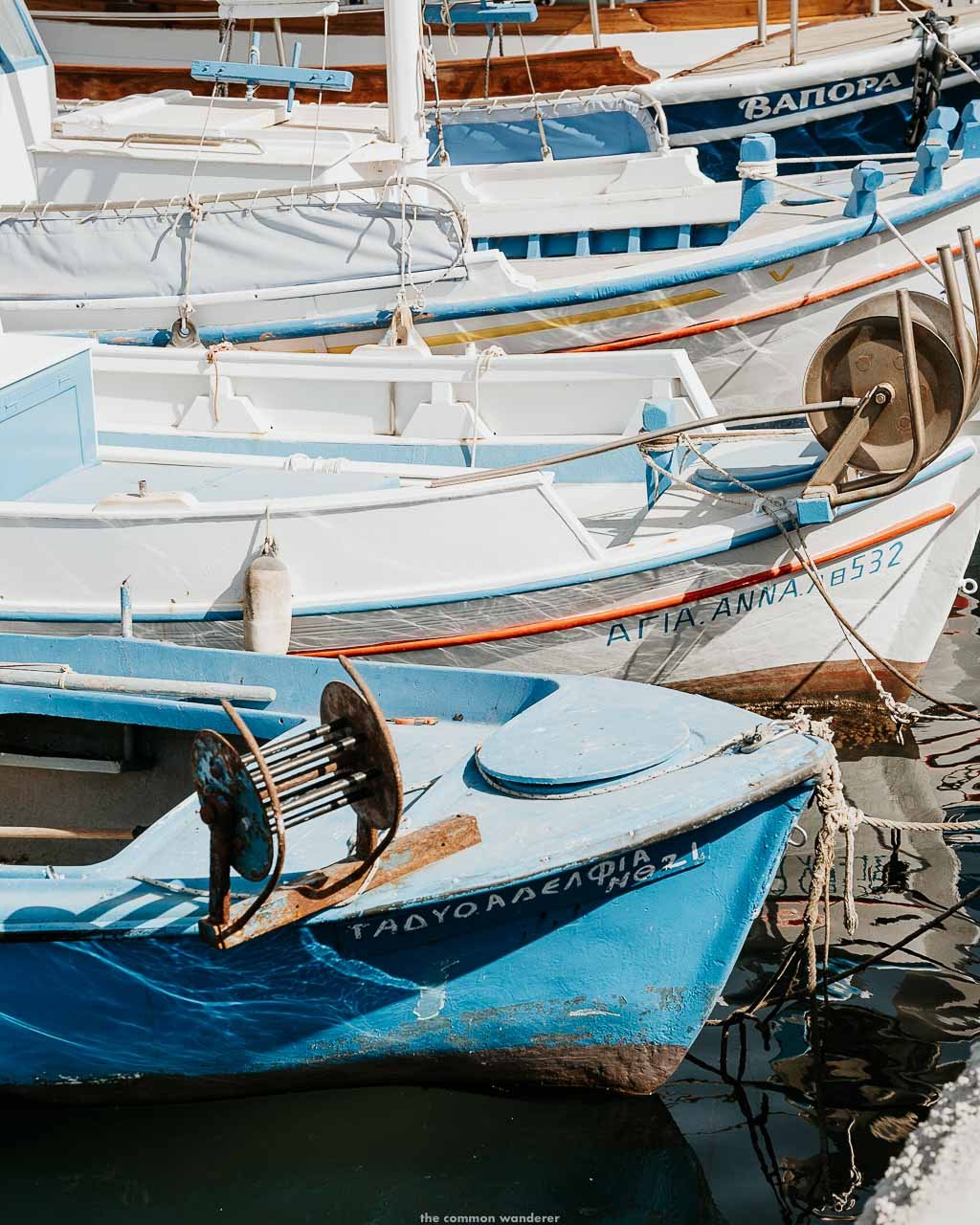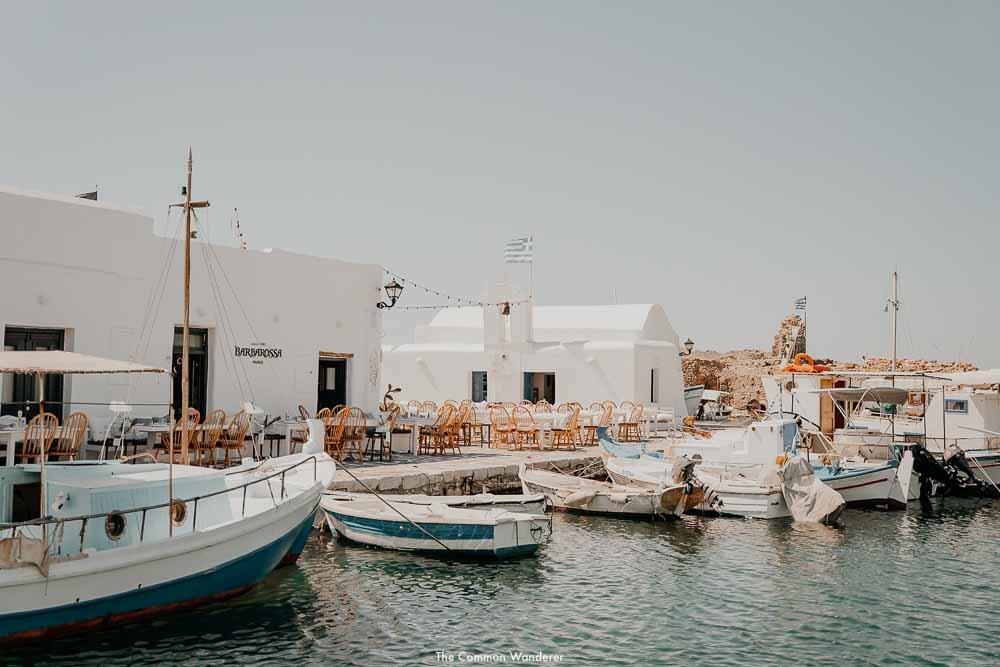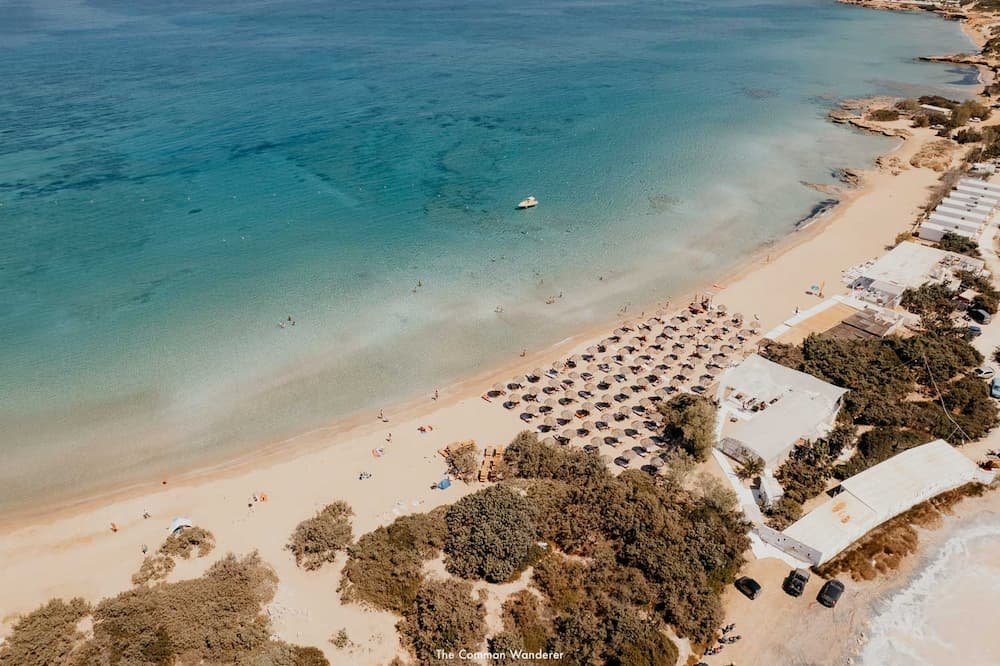23 Things to Know Before Visiting Santorini, Greece's Most Popular Island
Located in the southern Aegean Sea, Santorini is one of the world’s great destinations, famed the world over for its jaw-dropping scenery and epic hotels. Plan your dream trip with our Santorini travel guide. Discover its stunning natural beauty, explore the island's famous villages, take in breathtaking views of the caldera and learn about its rich history and culture.
Santorini is utterly breathtaking.
Set in the heart of the sparkling Aegean Sea, Santorini is rich in history, culture, cuisine, architecture, and natural beauty.
It’s a place where sheer red cliffs tower hundreds of metres high, encircling the salt-sparkled sea, sugar-cube villages domed with blue sprinkle the narrow ridges, cobblestoned lanes lead you through achingly beautiful villages, and picturesque wineries straddle the remaining lands, producing an abundance of excellent wine.
It’s also where the craggy land is all that remains of an ancient volcano that buried entire civilisations and drowned land with its fiery power.
This island, rebuilt from the ashes, is now one of the most popular destinations in the entire world, and with that comes a number of challenges. That’s why we’ve put together this Santorini guide, to help you make the right decisions to create the best possible Santorini getaway.
From what to see and do, where to stay and eat, and the best villages to visit, to the best dining and wine experiences, our post gives you all the information you need to enjoy Santorini.
Love our photos? They were all edited using our Europe Preset Pack, which you can purchase here!
SANTORINI
SNAPSHOT
WHEN TO VISIT | May - early July, mid-September - October
HOW TO GET THERE | Direct flight from Athens, Ferry from Athens or surrounding islands
WHERE TO STAY | Imerovigli, or outside of Oia
WHAT TO SEE | Oia, Ammoudi Bay, Megalochori, Pyrgos, wineries, take a sailing tour
WHERE IS SANTORINI?
Santorini (officially known as Thera) is a small island in the Cyclades, a group of islands in the Aegean Sea, and about 200km southeast of Athens. It's the most southern of the Cycladic Islands, with Ios and Anafi as neighbours.
Historically, its position in the maritime crossroads between the Mediterranean and the Middle East made it a strong trading port, but also a target for marauding pirates.
These days, it's home to 15 villages and is technically part of an archipelago comprised of Santorini, Thirassia, Aspronisi, and the volcanic remains of Palea Kameni and Nea Kameni, created after a volcanic eruption 3,700 years ago.
SANTORINI HAS A LONG, STORIED HISTORY
For thousands of years now, Plato's legend of Atlantis the lost city and civilisation that slipped beneath the waves without a trace, has captured the imagination of millions. Well, legend and some historians suggest that Santorini, and its ancient city of Akrotiri, may just be that lost city after the eruption of the Thera volcano some 3700 years ago.
Mind blown? Yep, so were we.
Back in the day, Santorini was a much larger island, home to one of the most advanced civilisations in the ancient world, the Minoans. Between 2600 and 1100 BCE, the Minoans built a sophisticated society centred on the city of Akrotiri, which was a thriving commercial centre with a complex urban infrastructure.
And then the island went kaboom.
Santorini was blown to bits by a massive volcanic eruption which caused a massive tsunami and buried the city of Akrotiri in volcanic ash (and destroyed Ancient Crete in the process), destroying the Minoan civilisation. The result is what you see today - a caldera, flooded with seawater, with two volcanic islands in the centre of the crater.
It took until the Dorians in the 9th century BCE for another settlement on the island to be established, becoming an important crossroad between the West and the East.
During Europe’s medieval period, Santorini was ruled by various powers, including the Byzantines, Venetians, and Ottoman Turks.
The Venetians took control of the island In the 13th century, establishing a thriving trading centre until it was seized by the Ottoman Turks in 1579.
After Greece achieved independence from the Ottoman Empire in 1821, Santorini became a part of the newly established Greek state. Like many Cycladic Islands, it became a thriving port with exports including wine, agricultural products, textiles etc.
Unfortunately, World War II was the start of a decades-long decline, and in 1956 a huge earthquake struck the island, causing huge damage to the island and its infrastructure (Oia castle is a prime example of said destruction).
Thankfully, the 1970s saw a regeneration of the island as a tourism destination (we wish we’d visited then!), transforming it into one of the most desired bucket list destinations in the world.
See, we told you it was a long, storied history!
HOW LONG SHOULD YOU SPEND IN SANTORINI?
We spent 5 nights in Santorini and found it was more than enough time to see all the sights comfortably; you could easily get away with 3 nights and still see everything you'd like to, especially if you had your own transport organised.
It's also worth noting prices on Santorini are almost double that of what you'd find on other islands, like Naxos and Paros, so spending less time here will stretch your dollars further on your holiday.
AVOID VISITING SANTORINI IN PEAK SEASON
We repeat, avoid visiting Santorini in peak season!
We’d avoid visiting Santorini in July and August, as the island is overwhelmed with tourists, making it an unenjoyable experience for all involved. Think crowded attractions, long lines at restaurants, high accommodation prices, traffic jams between towns, and lots of tension.
It’s simply not an enjoyable place to visit during this time, and your bucket list holiday will be ruined as a result.
So when should you visit Santorini?
No matter where we suggest travelling to in Europe, be it Paris or Hvar Island, we always suggest visiting during the shoulder seasons (either side of the peak seasons).
In the case of Santorini, this is between late April - early June, when the island is green and lush, and mid-September - October, when the tourists have mostly departed and the island slows down somewhat.
During this time, the days are still long and the weather and sea are warm, but the crowds are smaller and more manageable, making the island extremely pleasant.
What's more, the price of accommodation is much cheaper during the shoulder period - and you’re helping reduce the environmental impact while extending the tourism season for locals.
YOU CAN FLY DIRECTLY TO SANTORINI FROM MOST EUROPEAN CITIES…
Due to its popularity, there are daily Athens to Santorini flights during the summer months, there are direct flights from many European capitals to Santorini.
This makes getting to the Island, and the Cycladic Islands in general, a lot easier than say Paros or Naxos, which don’t have an international airport. It does however mean that Santorini suffers from extreme overtourism and noise pollution.
If you do fly directly to Santorini, you can take the 10-minute local bus to Fira for ~€2, or taxis will range between €30-45.
BUT THE BEST WAY TO GET TO SANTORINI IS VIA FERRY FROM ATHENS
As one of the Cyclades most popular islands, Santorini is super well connected by ferry to all other major islands and the mainland.
There are multiple daily ferries from Piraeus (the mainland Athens port) as well as nearby Cycladic islands. Ferries were our preference for getting around the islands, both for cutting down on unnecessary short flights, and also because they're generally the faster, more comfortable, and more affordable option anyway.
From the Ferry terminal, you can take the local bus to Fira for about €2. Alternatively, taxis are about €25-35 from the port to Fira and Imerovigli, while shared transfers are similarly priced.
BOOK | We booked all our ferry tickets through FerryHopper
AN ATV IS THE BEST WAY TO GET AROUND SANTORINI
If you want more flexibility and freedom with your Santorini itinerary, while not spending an absolute fortune on car rental, we suggest hiring an ATV.
In peak season, you'll want to be able to zip about more freely than you can in a car or by local bus, and the ridiculously tight roads, and lack of parking, mean that hiring a car is highly irresponsible.
We hired an ATV through Tony's in Fira, and we'd do it again in a heartbeat. Genuinely the loveliest family-run business who really cared about the safety and comfort of customers — they picked us up from Imerovigli when we rented our ATV and wouldn't let us leave the premises without going for a proper test drive — and also had some of the best rates on the island.
Note that to rent a scooter in Greece you'll need to show proof of a motorbike license.
///
Alternatively, buses are the cheapest mode of transport in Santorini, and the network is pretty good and reliable. Most tickets between major hubs generally cost around €1.80 (the most we paid was €2.50 for a ticket) and are paid in cash to the bus driver. Most buses connect in and out of Fira, which is the only super annoying part (like when you're trying to get between Oia and Imerovigli, but have to switch at Fira!).
The buses themselves are decent; they're air-conditioned and comfortable, although in peak season they fill up seriously quickly and you may find yourself standing. They run frequently, although the timings are sometimes a little limiting when you want to pack lots of Santorini's best things to do into a single day.
During the peak of summer, we'd recommend getting to the bus stop early and being prepared to queue for a while (it can also get pretty pushy!).
BOOK | Search and book ATV & car rental on Santorini
OIA IS OVERWHELMINGLY BEAUTIFUL…
There's a reason Oia’s become the place to visit in the Greek Islands; the traditional buildings cascading down to the water, pops of blue from church domes, pretty windmills and world-class shopping and food are breathtaking to see and a charm to explore.
The main thoroughfare gets shoulder-to-shoulder busy, especially in the early evening, but duck off the main stretch and it's not hard to lose yourself in quiet, hidden alleyways.
The most popular places for sightseeing in Oia are:
OIA CASTLE | As mentioned above, the popular sunset spot on Santorini!
OIA WINDMILLS | The Oia windmills are just a couple of the handful of traditional windmills remaining on the island, historically used to mill flour.
ATLANTIS BOOKSTORE | One of our fave bookstores in the whole world! Full of cosy nooks, a great selection of books, and a beautiful deck with epic views over the caldera
THE BLUE DOMES OF SANTORINI | The churches of Agios Spiridonas and Agios Anastasis are some of the most recognisable Greek islands icons, and the many laneways and alleys around here are gorgeous to get lost in.
KASTRO HOUSE | These gorgeous rust-coloured apartments will have been all over your IG feed already and for good reason - they're super cute!
CHURCH OF PANAGIA PLATSANI | You can't miss this famous Santorini attraction - it's in Oia's bustling main square in the heart of the town
Oia's insta-popularity precedes it, and with great fame unfortunately often comes great douchebag behaviour.
Oia might feel like a fairytale, but people do still live here as they've done for centuries, so climbing on roofs (especially churches), over fences and signs marking private property, and generally just being obnoxious and inconsiderate to get your Instagram shots really isn't cool.
READ MORE | Our curated guide to Oia, Santorini
BUT THERE'S SO MUCH MORE TO SANTORINI THAN OIA (WHAT TO DO IN SANTORINI)
In so many places, Santorini feels like an island that exists solely for tourists.
But travel just a few kilometres beyond the Caldera, and you'll discover rustic, traditional villages, vineyards, and cute little fishing villages that are worlds away from the hustle and bustle of Oia and Fira.
Here’s what else we think you should see while in Santorini:
VISIT (AND CLIFF JUMP!) AT AMMOUDI BAY
Ammoudi Bay is a quaint former fishing village nestled into the red cliffs right underneath Oia. The two are connected by about 300 steps from Oia Castle, though you can also drive down to the bay itself (which we did).
The bay is lined with gorgeously rustic fish tavernas where water laps right at the table's edge and the day's octopus hangs in the sun to dry. The walking path weaves through the taverna patios; Ammoudi Fish Tavern is the most popular.
Once you've reached the last taverna, you can also continue along the dirt track for about 5-10 minutes to reach a picturesque bay that's super popular for swimming and cliff jumping throughout the day.
RELATED | Our guide to Ammoudi Bay
MEGALOCHORI
Megalochori is one of Santorini's most charming and traditional towns; a true warren of white-washed buildings and blue-domed churches, pretty main squares flanked by tavernas, and peaceful hidden laneways.
Megalochori’s status amongst the wealthy wine merchants, land barons and traders of the 17th century is evident in the general beauty of the town and the grand mansions dotted about — whose high walls and solid wooden doors also provided protection against marauding pirates at the time.
Megalochori was one of our favourite places to visit on Santorini for a couple of reasons: the first was its obvious beauty and charm. The second was the sense that we were basically the only tourists there, observing 'true' life on one of Greece's most popular tourist islands.
KEEP READING | How to visit Megalochori Village
PYRGOS
On an island where tourism has taken over and some of the towns have become soulless (looking at you, Fira), medieval Pyrgos is charmingly authentic and beautifully preserved. The streets are narrow and winding, and all of them seem to weave up towards the Kastelli eventually.
Built in 1580, the Pyrgos Kastelli (Castle) is the 'youngest' of the five castles on the island, and in our opinion, the best place to watch the whole of Santorini and the vast Aegean Sea unfolding right before your eyes.
It's particularly breathtaking at sunset, especially if you can find a quiet corner to perch on amongst the ruins of the Kastelli.
Alternatively, if you're after a sundowner to accompany your view, Franco's Bar on the way to the top of Kastelli is a popular choice!
DO A WINE-TASTING AT DOMAINE SIGALAS
For such a small island in the Aegean Sea, Santorini certainly packs an outsized punch when it comes to its wine scene: 18 different wineries can be found nestled in the small slips of ancient land between the caldera and the sparkling sea.
Not many places in the world can boast such diversity of wine-making, which makes Santorini pretty special. Our pick of the bunch was Domaine Sigalas, an award-winning winery on the ancient plains surrounding Oia.
As with many Santorini wines, the most commonly used grape here is the local white Assyrtiko grape, planted in the arid volcanic ash-rich soil. You can pair a tasting flight (€16) with a tour of the vineyard, or opt for a tasting flight alone (we did the latter).
TAKE A TRIP TO SANTORINI’S VOLCANIC ISLANDS
Much of Santorini's landscape, villages, and culture are borne from the literal ashes of the eruptions that have torn it apart over millennia, so we suggest taking the volcanic explorations further by going to the heart of Santorini's volcano to the islands of Nea Kameni (literally means 'new burnt island') and Palea Kameni ('old burnt island'), in the centre of the caldera.
Both were formed during the eruption 400 years ago and Nea Kameni is still active; it last erupted in the '50s. For a totally different experience in Santorini, take a water taxi or a guided day tour from old Fira port to Nea Kameni and hike through the moon-like landscape to the top of the volcano's crater where steam still rises today.
EXPLORE SANTORINI’S VOLCANIC HISTORY AT AKROTIRI
Legend and some historians suggest that Santorini and its ancient city of Akrotiri might be the lost city of Atlantis after the eruption of the Thera volcano some 3700 years ago.
Akrotiri was only rediscovered in the 60s, and today you can tour the enclosed ruins.
It is less well-preserved than Pompeii — some of the buildings are little more than rubble — but for those who have a fascination with ancient cultures and civilisations, it's still a chance to go back a few thousand years and experience the island pre-Instagram and flowy dress shoots.
If you're looking for a guided tour of Akrotiri, we recommend this guided walking tour with a licensed archaeologist
READ MORE | Our guide to the best things to do in Santorini
SUNSETS ARE SACRED ON SANTORINI
Whether viewed shoulder-to-shoulder with thousands of others at the ruins of Oia Castle, from the infinity pool of your bougie hotel, or from the deck of your sunset cruise, Santorini's sunset is world-famous for a reason: it's pretty bloody spectacular.
The obvious choice for many is in Oia, and especially the Oia Castle, where the white-washed, blue-domed town and dramatic caldera cliffs are illuminated by pink, purple, and gold pastel light.
It’s a breathtaking experience — though you will have to share the magic with what feels like a million other people. It is, after all, the most famous place on the island (and maybe the world) for sunset (pro tip: visit Oia castle at sunrise for a more relaxed experience)!
Here are our favourite Santorini sunset locations, both in Oia and beyond:
OIA CASTLE | A stunning place to watch sunset, but be prepared to get there early to stake your place, take some water (or a beer!), and chat with those around you as you wait!
AROUND THE ‘BLUE DOME’ CHURCHES IN OIA | There are lots of lovely public laneways near the two famous churches that make for great vantage points as sunsets.
ON A SUNSET SAIL | There aren't many things better than a Santorini sunset.... except maybe taking a sunset cruise and watching the show over Oia from the deck of your own catamaran!
THE TOWN OF IMEROVIGLI | Smack in the middle of the caldera ridgeline and with the sun setting into the ocean directly in front of you, the town of Imerovigli has one of the best sunset views
THE PYRGOS KASTELLI | This was actually our favourite sunset spot on the whole of Santorini; the island rolls out before you and is a beautiful sight as the sun sets over it, plus the Kastelli is super quiet.
RELATED | Where to find the best Santorini Sunset locations
DON'T COME TO SANTORINI FOR ITS BEACHES…
Honestly, even Santorini's locals will tell you that most of their beaches aren't anything special; most can be skipped entirely during your stay in favour of hanging by your hotel's pool or by booking a sailing trip (or visiting our favourite islands, Paros or Naxos, after Santorini).
That said, if you're still keen to get some beach time in Santorini, here are a few tips:
WHITE BEACH | Soaring white cliffs above unusually clear blue water make for a beautiful sight here at White Beach, but getting there is an adventure in itself. Only accessible via boat, White Beach is a true Castaway experience.
Water taxis leave from the Red Beach parking area, and once you're here the secluded beach is yours to explore, snorkel, or swim to your heart's content. There are umbrellas here but no drinks or snack vendors so be sure to come well-stocked for the day.
THE BLACK SAND BEACHES | Santorini's volcanic history means most beaches are black sand. Perissa and Perivolos basically join to form one long volcanic sand beach with beach bars, tavernas, and comfy sunbeds. Both can be accessed by direct bus from Fira and are family and budget-friendly.
Agios Giorgios beach is their upscale sibling and can be found at the southern end of Perivolos, while popular Kamari beach, can also be accessed via a 30-min water taxi from Perissa, or by direct bus from Fira too.
RED BEACH | Red Beach, named for its crimson cliffs rising out of the crystal blue water below, is a breathtaking sight and features many guides to Santorini's best attractions. But the island's most famous beach has actually been officially closed since 2013 following a landslide and many subsequent rockfalls.
Thousands of tourists ignore the signs and crumbling cliffs each year and climb down anyway, but between the risk of landslides and the very minimal beach left to actually sit comfortably on, we'd say it's a risk not worth taking.
The beach can still be admired via boat, which is what we did!
SO EXPLORE SANTORINI FROM THE SEA INSTEAD
The views from the Caldera are pretty epic, but an awesome way to get a sense of their real scale and drama is from a totally different vantage point: the deck of a sailboat.
Captain Ted, the owner, is a colourful local legend well-known on the islands, and he’s been running Santorini Sailing tours around Santorini for years. We jumped aboard for a 5-hr half-day tour with them and had an awesome day soaking up that glorious Greek sunshine while also getting to explore in a romantic, adventurous way.
It's also worth noting that Santorini's beaches aren't renowned for their beauty or quality, so taking a sailing trip is the best way to get your fix of saltwater in pretty surroundings without feeling disappointed!
The day starts with a hotel pick-up and transfer to the Vlychada Port where your lux Catamaran sets sail. After a quick sail to the first swimming spot, it's straight off the side of the boat, into the sparkling blue water with snorkel masks in hand.
The day's sailing also takes in the white beach, red beach, Akrotiri Lighthouse, the volcanic island of Nea Kameni, and the dramatic scenery of the Caldera from the water. The crew also took us to their own secret sulphuric hot springs well away from the famous Santorini hot springs that often get super overcrowded. While the Springs themselves aren't much to write home about, not having to share them with anyone else was a definite bonus.
The crew also whipped up an amazing spread for lunch, with grilled meats and seafood, plus pasta dishes and salads for us veggies — all accompanied by a much-welcomed open bar.
Sitting on the deck and soaking up the sun while feasting on delicious food and chatting with new friends was one of the best things we did on Santorini.
BOOK | This highly-rated luxury Santorini catamaran tour
YOU CAN SKIP MOST OF FIRA
Fira is the island's capital, and where you'll find the biggest array of hotels, shops, and restaurants. It's also where most of the cruise ship crowds land, and where many of the public transport links leave from.
Look, a lot of people love Fira and find it beautiful, and that’s totally fine.
We’re just not those people. — and you certainly aren’t going to find any glowing reviews of it here.
For us, it was soulless, overpriced and trashy — with signs for fish spas (gross) on every second corner, pushy shop owners touting bog-standard tourist paraphernalia, and crappy bars spruiking overpriced watered-down cocktails and terrible food at double the price merely because of the caldera view.
Obviously, we're not huge fans of Fira, but given Santorini is one of those 'once-in-a-lifetime' places, we know that plenty of you (like us, pre-visiting!) will be keen to spend some time here regardless.
With that in mind, here are a few ideas for things to do in Fira worth a quick glance:
Wander the narrow streets of the Old Market area
Do the Fira to Oia walk along the Caldera in the morning (more on this below!)
Visit the Three Bells of Fira church (aka The Catholic Church of the Dormition)
Walk down to the old port and take the Santorini Cable Car back up
Explore prehistoric Santorini at the Museum of Prehistoric Fira and go back in time at the Archaeological Museum
You can pretty much skip the restaurants and bars here, especially those on the Caldera — honestly, the food is average and charged at double simply for the view.
STAY IN IMEROVIGLI
Forget Fira and Oia, the clifftop town of Imerovigli is the best town to stay in on Santorini by far.
It's the highest of the caldera towns, with sweeping views over the caldera, Skaros Rock, and endless sea making for some of the best sunset-watching on the island. But its real charm is in its peace and quiet, a marked difference from the atmosphere of the other main caldera towns that are a constant hive of activity.
Many of the more exclusive boutique stay on Santorini are actually here in Imerovigli, particularly on the Fira-Oia hike leading out of the village. But for those without endless pockets of cash, the good news is there are also plenty of lovely stays here for a fraction of the price tag too.
We stayed at Remezzo; once a traditional vineyard and cellar from the 1800s transformed into a beautiful family-run boutique hotel. While the hotel itself was beautiful, a mix of white-washed buildings and rustic pastel-converted barns and cellars, our favourite pastime was sitting on the terrace and taking in the 180-degree panoramic views of the island's wild volcanic coastlines and the magical sunset that seemed to drop into the sea right in front of us.
There aren't as many restaurant options in Imerovigli, but we can definitely recommend Anogi for its traditional food, friendly service, and generally warm and welcoming atmosphere.
Fira is also about a 20-30 minute walk away via the Fira-Oia pedestrian trail, which makes for an easy wander if you want more options.
Below are a few of our suggested hotels:
IMEROVIGLI | Luxury: Kapari Natural Resort, a sustainably-minded boutique eco-hotel, or the budget-friendly Remezzo Villas which also has a dream caldera view!
OIA HOTELS | Luxury: Canaves Oia Suites and Spa built into the cliffs of the caldera and with an epic infinity pool, pr the budget-friendly Volcanic Arc Suites
READ MORE | Where to stay on Santorini
SANTORINI IS VERY EXPENSIVE, DOUBLE THE PRICE OF OTHER GREEK ISLANDS
Santorini has a reputation for being very expensive, and for good reason; it's one of the most popular islands on the planet, yet it’s small, hard to get around, and filled with high-end accommodation options. As a result, when demand is high, so are the prices.
Accommodation, especially in popular areas such as Oia, can exceed €500 per night and will likely be your largest cost. Eating a meal in a restaurant can set you back at least €30 per meal, ATV rental can top €50 per day, and beers at sunset bars will set you back around €8-10.
BUT.
There are ways to make your Santorini getaway more affordable:
TRAVEL OUT OF SEASON | Probably the #1 way to save money is to travel during the shoulder season. If you can, travel from April - early June, or from late September. Due to decreased demand, accommodation is heavily reduced during this period
ACCOMMODATION | Book accommodation outside of Oia, in places such as Fira, Imerovigli, Pyrgos and Megalochori. Here, you can get apartments/Airbnb for under €150 per night. Just be aware of accommodation scams.
COOK YOUR OWN MEALS | If you rent a Santorini apartment, make full use of the kitchen. Visit the supermarket and buy breakfast, lunch and dinner options, as well as snacks for hiking. With this method, we saved at least €50 per day on food. There is a market in Fira that sells affordable vegetables, meat and cheese. Alternatively, live on Gyros.
PRE-DRINKS | Drinks are far cheaper from the supermarket, so buy booze in bulk and pre-drink before hitting up a sunset bar.
BEWARE OF SCAMS ON SANTORINI
We’re pretty clued in travellers - it’s kinda our job, and we pride ourselves of having really never been scammed. Ok, there’s been the occasional tuk-tuk in South East Asia that’s charged us a little more than normal, but nothing else of real note.
On Santorini, that all changed.
Having booked and paid for accommodation in Fira through booking.com, we arrived to find a room completely different to what was advertised. The room smelt of heavy cigarette smoke, and was in very dirty state. We spoke with management and tried to change rooms, although none were available. Or so we were told.
After complaining relentlessly, we were apologised to, and told we could shift to a new, better ‘sister’ hotel in Fira at no extra cost. We smugly agreed, and made our way to the new sister hotel, overlooking the caldera on the edge of Fira. All seemed well, until we were chaperoned into a dungenous room, heavy with mildew and and no windows. “You stay here”, we were told.
At this point, we knew we were being scammed.
Upon rejecting the room, the owners suggested another room, but for an extra €50 per night. We said no and demanded a clean room at no extra cost. Our request was wholeheartedly rejected. At this point, the atmosphere turned very sour, to the point that three young men surrounded and threatened us. We decided to leave and return to our original hotel to sort out the issue.
Management apologised to profusely, and again told us we could return to Fira and take a caldera view room at no extra cost. Frustrated and angry, we returned to Fira, to extreme hostility. The men again asked for us to pay an €50 per night, refusing to let us past the reception unless we agreed. We didn’t, and got on the phone again with the owners, who eventually allowed us to stay at the original price.
The overnight stay was horrible, with music pumping above us until the early morning, and thankfully we checked out the next morning.
After reading numerous TripAdvisor reviews, this scam seems pretty common on Santorini, especially in Fira - book one room, get another, ask to change, told you’ll get an upgrade, forced to pay more for upgrade, then given another loud, dirty room.
I guess what we’re saying is, if accommodation seems to good (cheap) to be true, it most definitely is. If you’re ever in this situation, refuse to pay the upgrade and walk away, and complain again and again and again until management relents.
For visitors to Santorini, there are a few other scams we’ve read or been told about, that we think you should know about:
THE SWITCHING MENU SCAM | One menu has normal prices, which you order off. When the bill arrives, it’s far more than expected. You complain, and are then shown a menu with the inflated prices. The owner threatens to call the police, so you pay the inflated prices. We suggest always take a photo of the menu when you arrive.
ATV/SCOOTER SCAM | A common scam in Greece, the modus operandi is to offer faulty ATVs or scooters at affordable prices, but if the vehicle is returned ‘damaged’, is in an accident, or breaks down, they will demand that the customer pay for the whole cost of the vehicle. Make sure you read through all the rental and insurance details, and thoroughly check your vehicle (take videos of every scratch/bump) before leaving. If the vehicle feels faulty, ask for a new one immediately.
CURRENCY EXCHANGE / EURONET ATMS | A classic scam, offering bad rates and hiding dodgy fees that mean you lose our on a lot of money. Always exchange an official exchange office, and never, ever use EuroNet ATMs - use main Greek bank ATMs.
DON'T TAKE THE DONKEY RIDES
So here’s the deal. Mules and donkeys have been used since time immemorial to shuttle goods and people from Santorini’s ports to the caldera settlements above.
But as time moves on, knowledge and respect for animals increase, and humans get heavier, it’s clear that donkey rides are an outdated solution. Plus, it’s just fucking cruel to ask a small animal to carry a human up a hill in 40-degree heat.
The issues around their mistreatment are well documented and supporting animal tourism is always unethical in our view (read our guide to responsible travel here). In 2018, legislation was introduced by the Greek government to curb the demands on donkeys, making it illegal to carry weight over 95kgs, which according to animal experts, is nowhere near enough.
The solution? Use your two legs, and walk. For those with physical limitations, there are alternatives, such as driving (You can organise a taxi from Ammoudi Bay to Oia for €10), or using public transport (bus, cable car).
But overall, tradition isn’t an excuse to continue the barbaric treatment of these animals, so please, refuse to take a donkey ride in Santorini.
WATER IS IN SHORT SUPPLY ON SANTORINI
Santorini receives very little rainfall, so unsurprisingly, suffers from extreme water shortages, particularly during the peak tourist season, when the demand for water is absurdly high (all those cliffside pools need water…).
Water is either shipped to the island or supplied through small desalination plants, which means stress on the water infrastructure, especially when you consider 2 million people visit the island each year.
To help reduce the pressure on water supplies, keep your water usage to a minimum. We know that’s hard to do on holidays, but quick showers, and turning the tap off when brushing your teeth, cleaning etc. really help.
REMEMBER TO NOT FLUSH YOUR TOILET PAPER
In Greece, and especially on the Greek Islands, the sewerage pipes are antiquated and narrow, and therefore clog very easily. As a result, it’s customary to not flush your toilet paper in Greece, which takes a little getting used to, let us assure you.
So what do you do instead?
We know it’s disgusting, but wrap your poop paper, and pop it in the provided bins in all Greek restrooms.
YOU CAN DRINK THE TAP WATER ON SANTORINI, WITH CAUTION
The good news - you can drink the tap water on Santorini.
The bad news - you should probably still use a water filtration bottle, just in case.
Although the tap water is fine, Santorini has no natural sources of fresh water, so it’s either shipped in, or supplied through desalination plants. The mineral content is therefore very high, so can take a little getting used to for our bodies. The result could be a bit of a dodgy tummy for a few days, and it’s maybe not worth it if you’re only visiting for a short period. Do note that the water is safe for brushing your teeth, and washing.
We’re totally against buying plastic bottles, especially on the Greek Islands, where plastic pollution is a huge problem.
Our advice - buy this water filtration bottle before leaving, and you can drink safe, fresh water everywhere you visit. It’ll save you a heap of Euros in the long run, and also save marine animals and those pretty beaches you like to relax on.
HOW TO BE A RESPONSIBLE TOURIST ON SANTORINI
Responsible, sustainable travel is what we’re all about here at TCW HQ, and this is especially true when we travel to places suffering from climate change and plastic pollution, such as Greece.
Disappointingly, we encountered quite a bit of plastic pollution during our Greece trip — a sad reality of our planet today! — so we feel it’s super important to share a few tips on how you can minimise your overall impact while still having the Greek holiday of your dreams.
DON’T BUY BOTTLED DRINKS | Millions of plastic bottles are used on Santorini each year and they are commonly found littering beaches. Please, for the love of the ocean: DO NOT BUY SINGLE-USE PLASTIC BOTTLES! Buy one of these amazing bottles instead
USE LESS WATER | See above.
TRAVEL DURING SHOULDER SEASON | Shoulder season is the time before and after the peak season when things are quieter, cheaper, and more enjoyable (especially in the Med!). Travel then to reduce over-tourism, and extend the season for local operators
OCEAN-FRIENDLY TOILETRIES | Everything that goes down the boat drain ends up in the ocean, try and make sure all your toiletries, sunscreen, and shampoo is as ocean-friendly as possible! Solid bars are a great place to start (see below to buy some eco-friendly toiletries).
DO YOUR OWN CLEANUPS | See rubbish on the beach, forest or town? Pick it up, and dispose of it properly. If every traveller helped out during their holiday, the beaches, oceans and forests would be a much happier place for it
DON’T USE PLASTIC BAGS | Pack a reusable tote and use these to carry your snacks, drinks, or new souvenirs instead
LEAVE NO TRACE | Limit your consumption of plastic, and opt for sustainable / zero-waste alternatives instead. Pack a reusable water bottle, bring your reusable coffee cup, and if you can’t sip your cocktails without a straw, bring a metal or bamboo one along instead. And never leave a trace...
SUPPORT THE LOCAL COMMUNITY | Visit a locally owned taverna for a meal, and buy which means both supporting the local economy and community, and also giving you a real authentic experience.
ICE CREAM CONE | bonus tip - eat your ice cream in a cone, rather than a cup and plastic spoon for the ultimate plastic-free indulgence!
THESE ARE YOUR SANTORINI PACKING ESSENTIALS
Travelling through Santorini comes with a unique set of needs.
To help you have a comfortable, happy journey, we recommend bringing the following items with you:
REUSABLE WATER BOTTLE | THE BEST INVESTMENT WE’VE EVER MADE! We use the Grayl water purification bottles, which allow us to fill up from any water source, anywhere in the world (including train taps!)
A TOTE BAG | The humble tote is a versatile little lifesaver when on the road. They're plastic-free, small, easily foldable, and can pack a surprising amount! Check out this range of beautifully designed, personalisable totes bags here
BIODEGRADABLE WET WIPES | Keep clean without destroying the planet!
HAND SANITISER | This is not something we’d actually recommend normally, but we now live in Covid times... so this can be a bloody great investment
INTERNATIONAL TRAVEL ADAPTER | You’ll need a European plug to keep your gear going!
POWER BANK | Don’t get caught out without power for your devices
EYE MASK | For those annoyingly early European sunrises!
BIO-FRIENDLY TOILETRIES | Avoid damaging and chemical-heavy products and facial scrubs with microbeads altogether. We recommend Lush solid shampoo, conditioner and bodywash bars, ocean-friendly sunscreen (Stream2Sea), a mooncup is a great investment for “that” week and Lip balm for the sun
A FEW FINAL TIPS FOR SANTORINI
Before visiting Santorini, here are a few extremely obvious tips that might seem obvious, but are always good to know, especially for first-time visitors to Greece, or even Europe.
The currency in Greece is Euro
ATMs are in abundance throughout Santorini island, including the smaller villages such as Pyrgos and Megalochori. We suggest always carrying some cash, especially for buses. When paying by card, always pay in the home currency ie. Euro
The electrical plug type you’ll need is C, E & F. They range from 220 - 240 Volts
We suggest buying a Greek sim card before arriving on the island. The network is mostly 4G.
Wi-fi is common, but never fast due to the influx of tourists. Expect 2010-level speeds
You’ll likely be covered by the Schengen Visa, which gives you 90-days travel in Europe, per 180 days
In Greece, siesta / mesimeri occurs between 2 pm - 5 pm. For Santorini, this might mean that some businesses shut down over these hours, especially in the smaller villages. Plan accordingly, or else you’ll miss out on lunch, like us
TRAVEL INSURANCE | STAY SAFE IN GREECE
If you can't afford travel insurance, you really can't afford to travel. As the current global situation has taught many people, things can go wrong anywhere in the world - and insurance is often the only way of mitigating any issues with minimal expense or stress for you.
Here are our recommendations, based on 8+ years of full-time travel:
FOR TRAVELLERS | HeyMondo - COVID-19 coverage, comprehensive travel + medical insurance, an app with 24-hour medical support, and no out-of-pocket fees. *Get 5% off your policy by booking through our link here.
FOR DIGITAL NOMADS | SafetyWing - COVID-19 coverage, comprehensive travel & medical, and policies can be purchased while already abroad.
CAR INSURANCE | Insurance4CarHire - a great annual car insurance policy
PLANNING A TRIP TO GREECE SOON?
Check out these essential guides, travel tips, and more to help you plan your trip:
SANTORINI ATTRACTIONS | The best of Santorini, A complete guide to Oia, Santorini, Exploring the stunning Ammoudi Bay, How to visit Megalochori Village, Our guide to hiking Skaros Rock, How and where to find the best Santorini sunsets, where to stay in Santorini
THE BEST OF NAXOS | Top things to do on Naxos, Where to stay on Naxos Island, Things to do in Chora Town, A guide to the pretty town of Halki, A guide to Plaka Beach, Agios Prokopios,
EXPLORE PAROS | The best things to do on Paros, A guide to Naoussa town, A guide to Lefkes, A short guide to Parikia Paros, Where to stay on Paros
MYKONOS DREAMING | What to see and do on Mykonos
GREECE SAILING | This is what it’s like to sail the Greek Saronic Islands with Medsailors
PHOTOGRAPHY | Love our photography? Wondering what gear we use to get all of our photos around the world? Click here to view our detailed photography gear guide, as well as our top travel photography tips!
RESPONSIBLE TRAVEL | Responsible travel is important. REALLY IMPORTANT. Learn our top responsible travel tips to help you, your family and your friends travel more consciously around the globe
ECO-FRIENDLY PACKING ESSENTIALS | Don’t leave home without our favourite eco-friendly travel essentials
PLAN YOUR GREEK SUMMER WITH OUR USEFUL GUIDES
Some of the links in this Santorini travel guide are affiliate links.
If you choose to purchase using these links, we receive a small commission at no extra cost to you. Please know that by using these affiliate links, you're directly supporting The Common Wanderer to stay wandering, the running costs of the site, and our ability to provide you with free content to help you on your travels.
That, and you're officially a legend.

